Retrospective
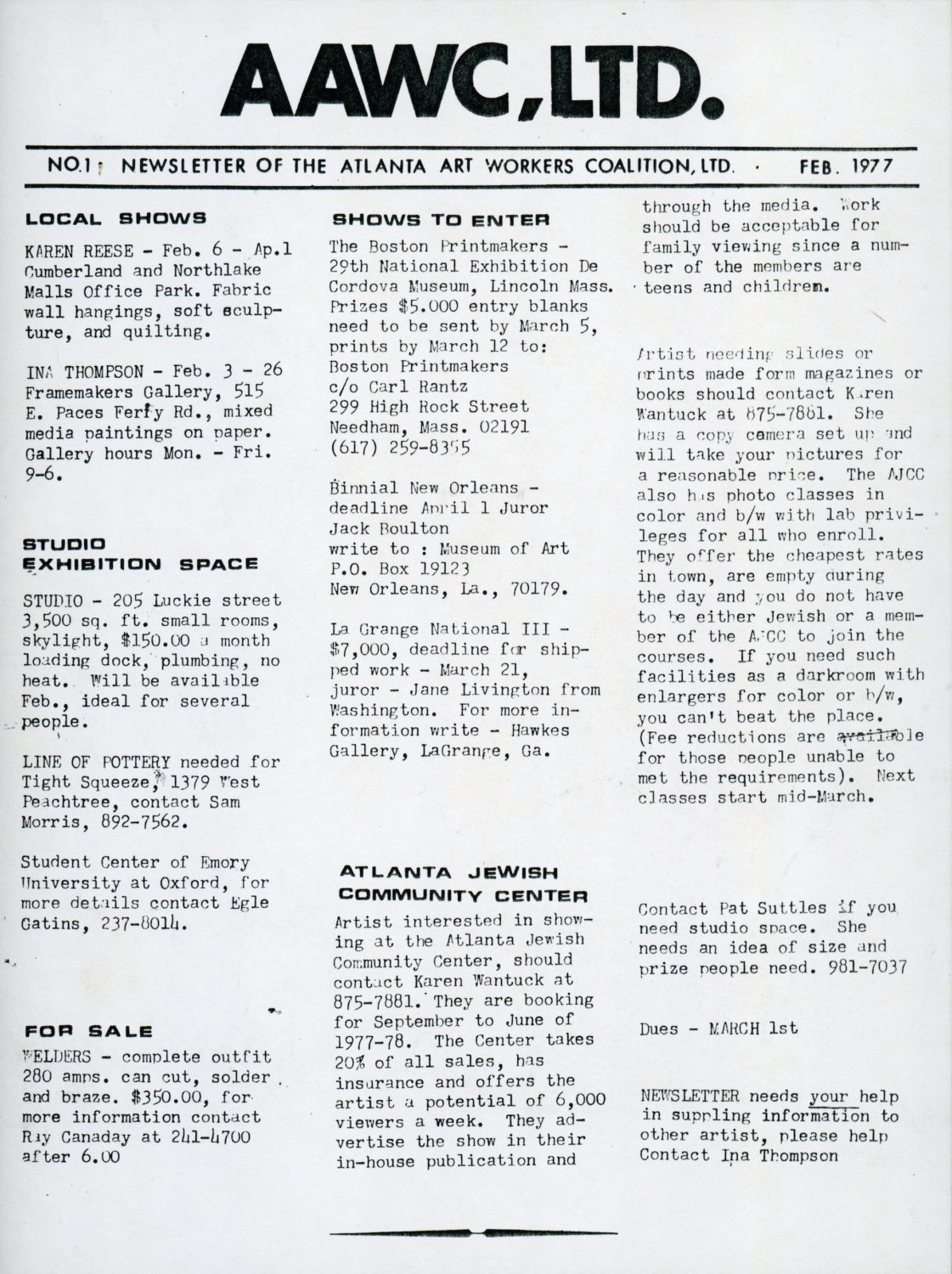
1977
The AAWC Newsletter
Established in early 1976, the Atlanta Art Workers Coalition Ltd. was a non-profit organization dedicated to the exchange of ideas and information among Atlanta-based artists. The first issue of the AAWC Newsletter (see photo), published in February 1977, was a single-page, hand-typed flyer containing several classified ads for items such as studio space, exhibition listings and opportunities. The second issue was similar but contained a photocopied reprint of an article from the Medical Tribune on lead and toxemia risks for artists. By mid-1977, AAWC received long-awaited grant money for two staff positions: the NEA-funded Director of Activities, to which Julia Fenton was appointed, and a curatorial position funded by CETA, for which Dan Talley was hired. Consisting of a gallery space and informal offices, the coalition held regular meetings to discuss local, regional, national and international art issues while organizing exhibitions of artists from Atlanta and beyond. The newsletter continued to be published almost monthly, and by the end of the first volume it had expanded to several pages and contained a significant amount of information including employment opportunities, workshops and classes, and news from similar Southeastern organizations.
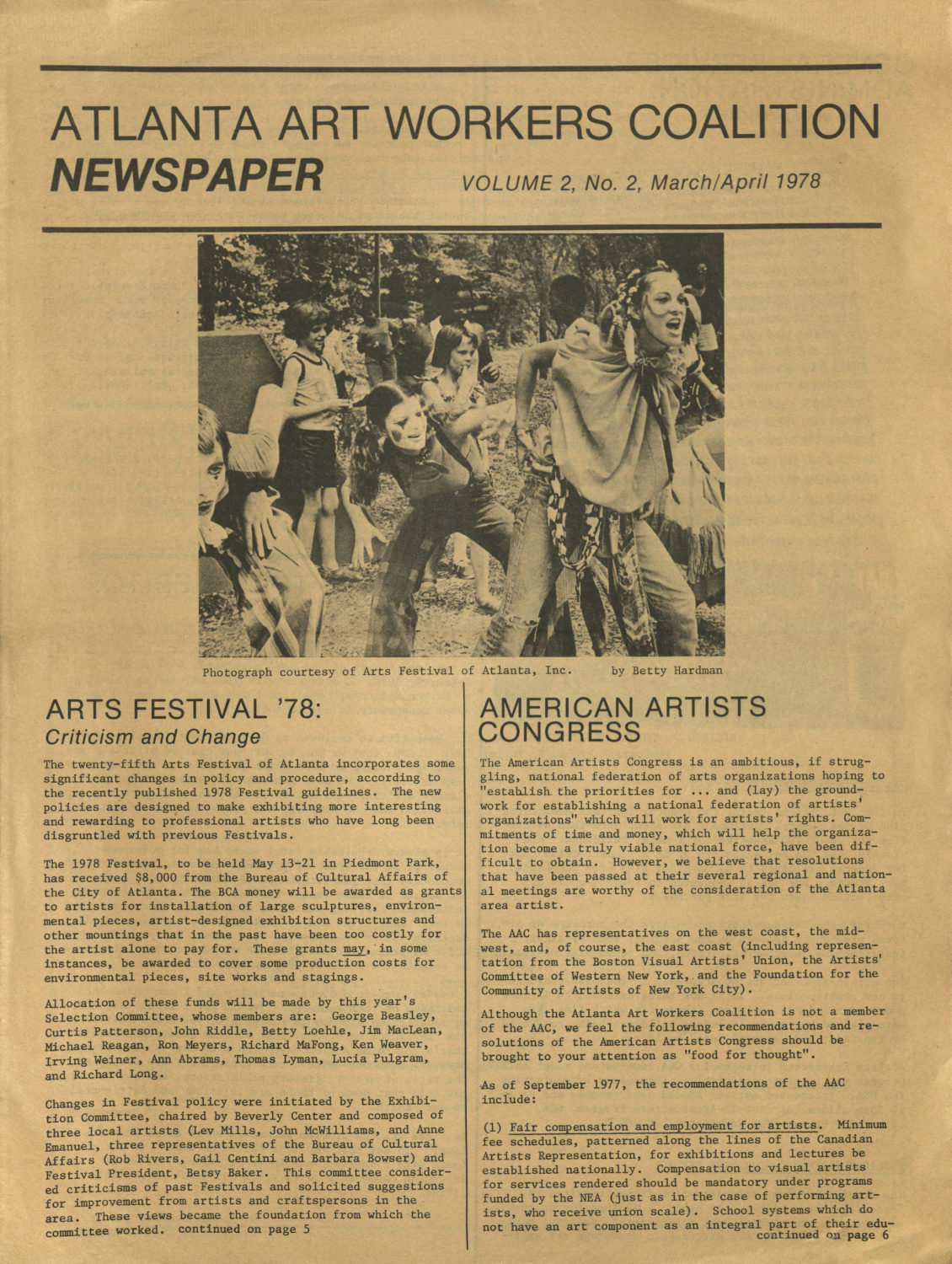
1978
From Newsletter to Newspaper
Atlanta Art Workers Coalition staff members Julia Fenton and Dan Talley were particularly interested in expanding the coalition’s modest newsletter begun the previous year into a legitimate publication for the second volume. Thus the Atlanta Art Workers Coalition Newspaper was established in the bimonthly, tabloid-size format that the publication would maintain for the next 24 years. As Founding Editors, Fenton and Talley shared a mission to cover art in the Southeast region within a broader national or international context. They did so by running “Artist to Artist” interviews along with articles on the controversial “Artists in Georgia” exhibition at the High Museum of Art, the Arts Festival of Atlanta (see photo), and, less close to home, performance art in Southern California. The newspaper also expanded the information sections from the original newsletter, running an extensive listing of Atlanta gallery opportunities and a special issue on funding guest edited by Gary Sipe, which included an article on Jimmy Carter’s CETA employment program and the American Artists Congress. Also published were the first Artist’s Pages, in which chosen artists such as Marcia Cohen were given a page of the newspaper to turn into an original work of art, and a call for writers to accommodate the newspaper’s growing needs. Already active as a volunteer, future Associate Editor and current Surviving columnist Barbara Schreiber made her writing debut that year.
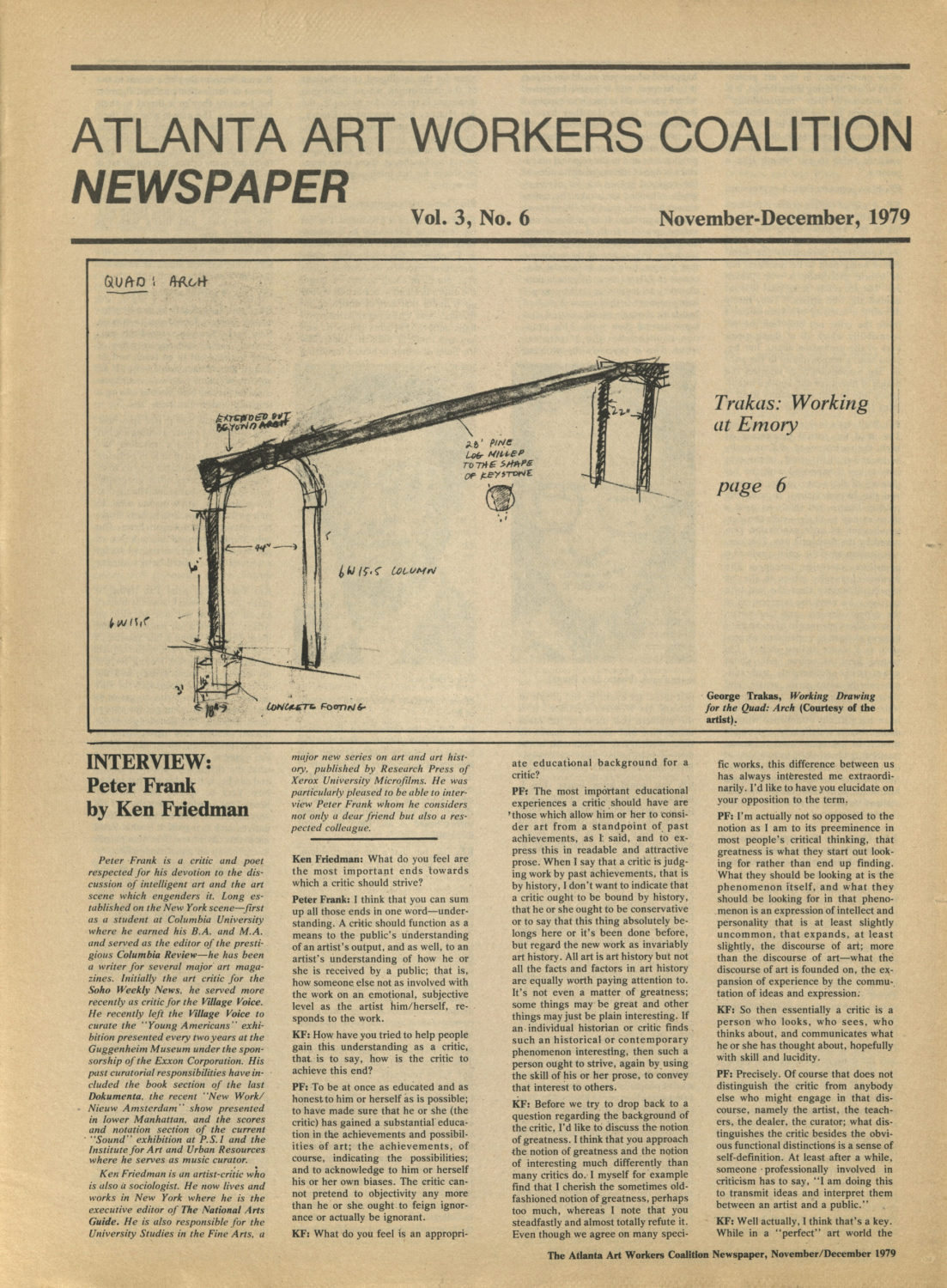
1979
Local Artists and Beyond
The Atlanta Art Workers Coalition Newspaper took on an ambitious editorial direction in volume three under Founding Editor Dan Talley and new Editor Laura Lieberman. The Artist to Artist series continued with a dialogue between a very young John Turturro and Laurie Anderson, and other youthful interview personalities included artist Alan Sonfist and critic Peter Frank, who is currently a member of the magazines Editorial Advisory Board. Many topics at this time highlighted Atlantas rising cultural scene thanks to the growing Arts Festival of Atlanta, public art in the new MARTA transit system and at the expanding Hartsfield Airport, which included a rejected proposal by Dennis Oppenheim, and the beginning of the Fulton County Art Council, a major funder of the publication to this day. Also included were articles on George Trakas (see photo), Nancy Spero, Michelangelo Pistoletto and Mary Beth Edelson, the latter three visiting Atlanta and having exhibitions at such venues as the Women’s Art Collective. Particularly relevant were the published transcripts of a critical symposium on regionalism in which Donald Kuspit and John Howett espoused various theories on this growing issue. Other key topics included artists books, the 19th century Atlanta art scene and the history of the world famous Atlanta Cyclorama, and a series of articles on black and white artists in the state including Georgia Expatriate Benny Andrews. The publications first review section appeared in the JANUARY/FEBRUARY 1979 issue.
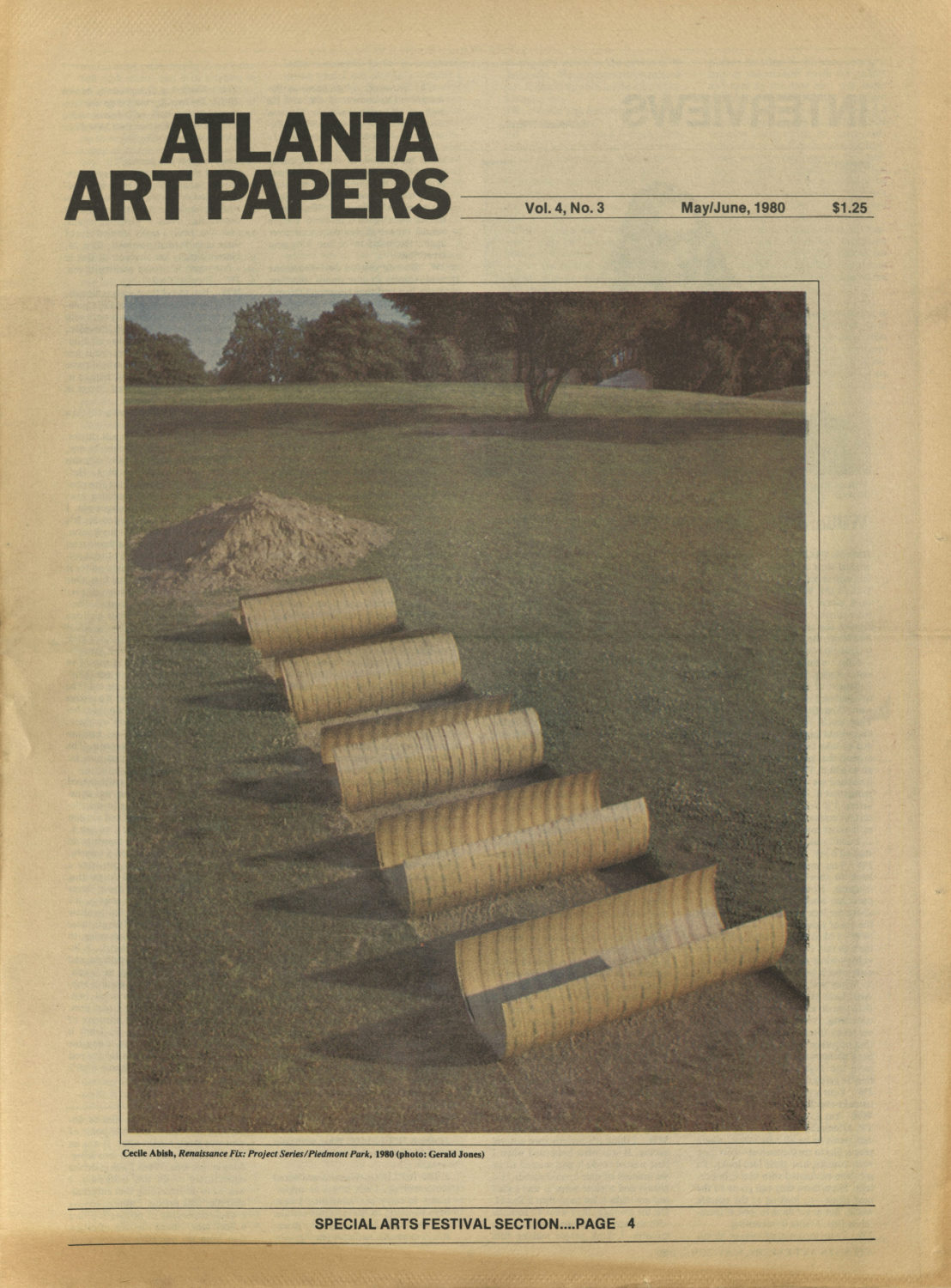
1980
Atlanta Art Papers
Ending the affiliation with the Atlanta Art Workers Coalition in order to gain editorial autonomy, with the March/April 1980 issue the Atlanta Art Workers Coalition Newspaper became the independent non-profit organization Atlanta Art Papers Inc. The “new” publication, Atlanta Art Papers, continued the editorial mission of Dan Talley and Laura Lieberman, focusing throughout volume four on an international art dialogue within a local and regional framework. Memorable interview subjects include William Wegman, Kenneth Anger, and Cecile Abish (see photo), whose work was included in an issue on an ambitious program of site-specific sculpture at the Arts Festival of Atlanta and subsequent discussions of critical issues in sculpture. Continuing was a series of articles begun the previous year on avant-garde music by Dick Robinson, while originating in this volume were the first reviews by New Orleans Contributing Editor D. Eric Bookhardt, the magazine’s longest serving writer. Of particular interest was a two-page published proposal for an environmental project by noted artist team Helen and Newton Harrison.
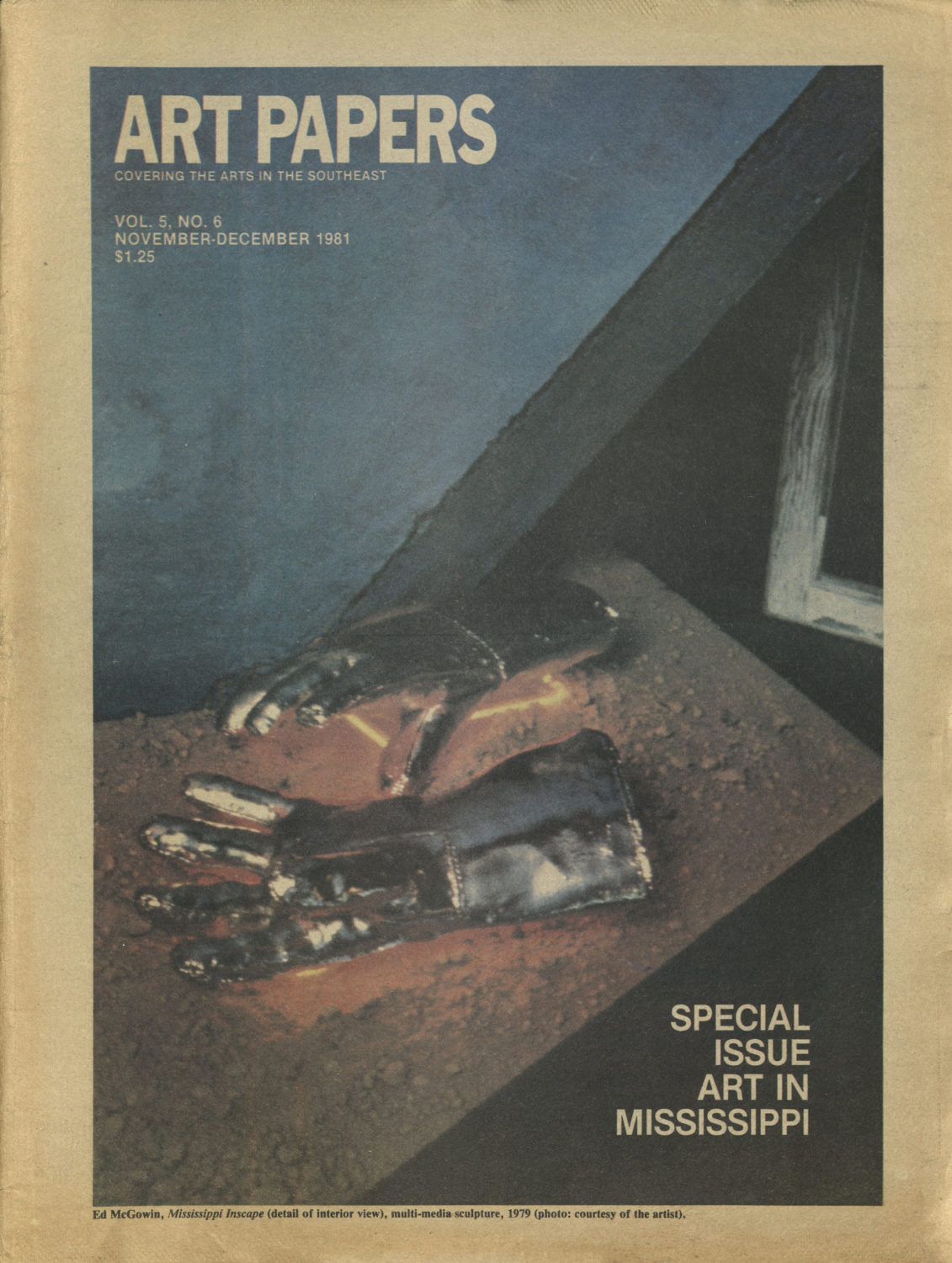
1981
Finally It’s Art Papers
Early in volume five Atlanta Art Papers absorbed the regional Atlanta-based arts journal, Contemporary Art Southeast, and in so doing dropped the word “Atlanta” from the publication title but added the subtitle “Covering the Arts in the Southeast.” Containing all color covers, the publication strengthened its local and regional base with special issues on art in Mississippi (see photo) and the Arts Festival of Atlanta along with major articles on crafts and the history of photography in New Orleans. At the same time, however, substantial articles on film and music, including one on composer Steve Reich, were run along with interviews with Duane Hanson and Vito Acconci, who had recently completed an installation at the Atlanta Art Workers Coalition Gallery. Other articles focused on architect Richard Meier, whose High Museum design had recently been accepted, and Suzi Gablik, the critic who would later become a contributor to the publication.
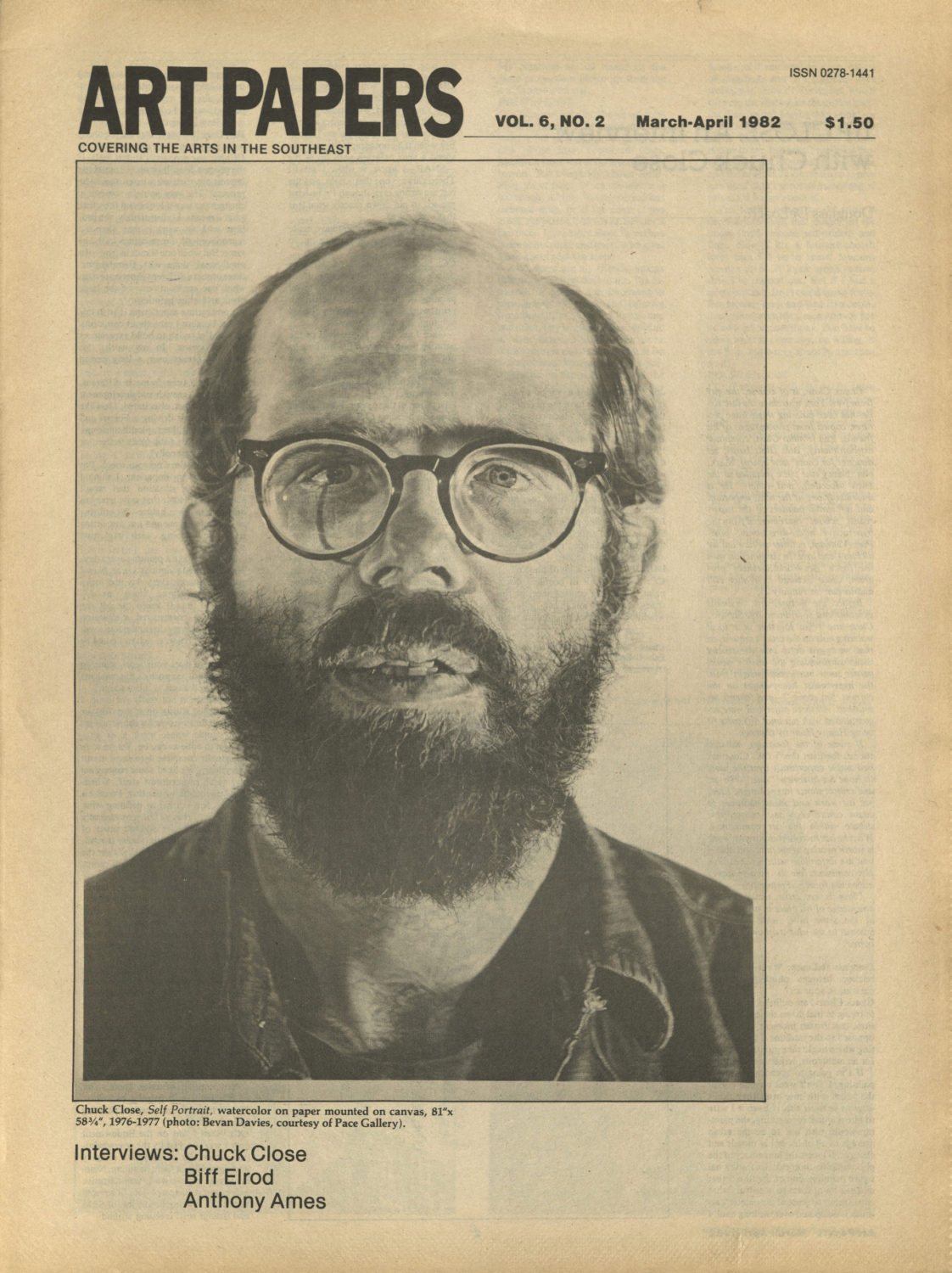
1982
Art, Music, and More
In volume six, critic and artist Ronald Jones, who had published his first article on Southeastern media artist Chris Robinson the previous year, contributed notes on recent European painting that, along with interviews with Marcia Tucker, Chuck Close (see photo), and Allen Ginsberg, made it clearer than ever that the magazine was interested in more than the Atlanta scene. On the other hand, a story on the importance of DB Records within alternative music also made it clear that nationally significant institutions in the magazine’s home town would not be ignored. Tom Patterson’s essay on Nexus (now the Atlanta Contemporary Art Center) inaugurated a six-part survey of Southeastern artist’s spaces, and a story on Alternate ROOTS (Regional Organization of Theatres South) reaffirmed regional connections. Features on “Dance in Atlanta” and an obituary of folk artist Nellie Mae Rowe reflected a continuing determination to cover all the art forms of the local scene. Anthony DeCurtis, who was already writing for Rolling Stone, reported on the first local fallout of the culture wars, the resignation of the Atlanta Bureau of Cultural Affairs director in the wake of the “Art for the People’s Sake” film and performance festival.
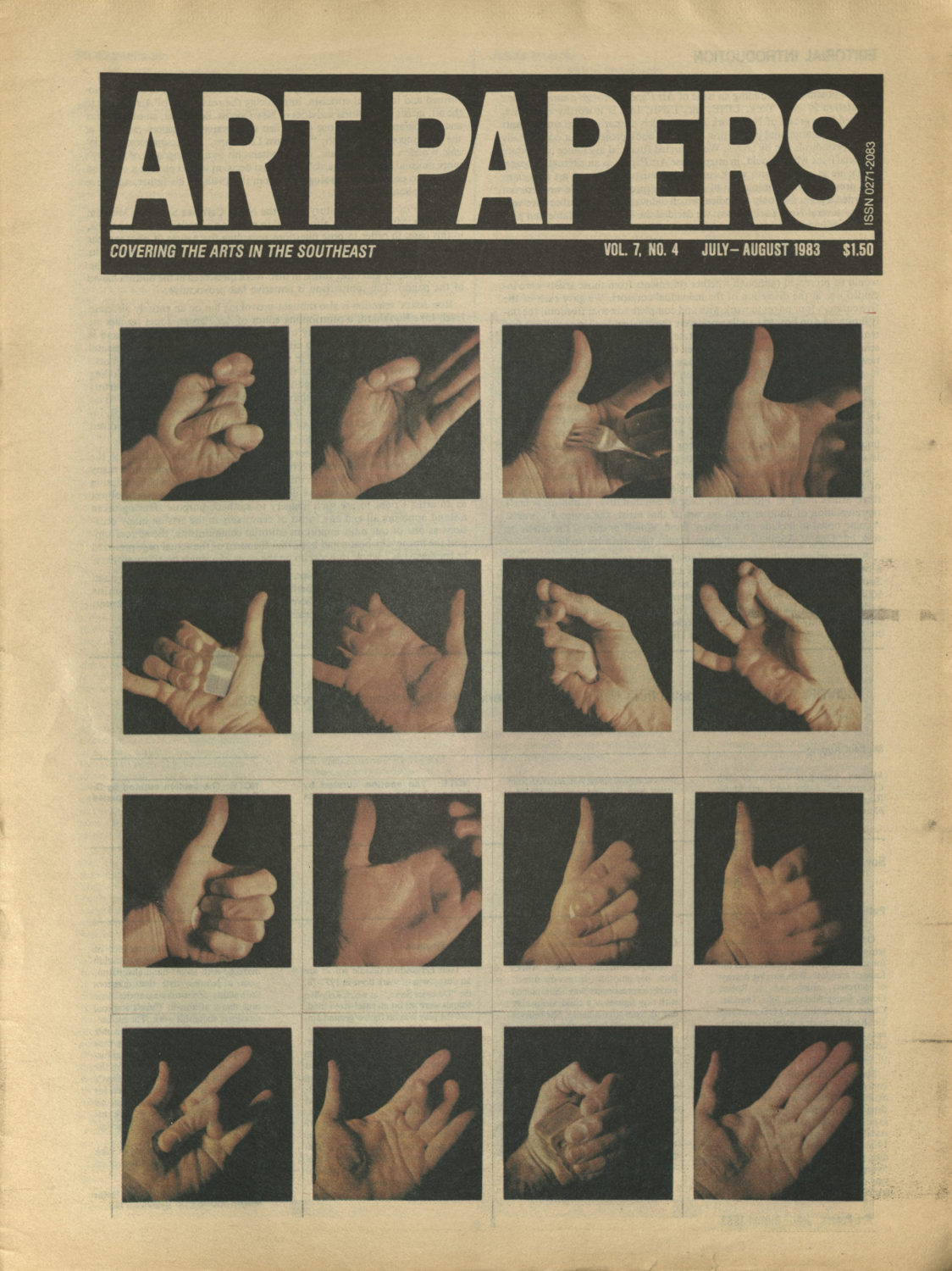
1983
Curator’s Pages
An ongoing interest in architecture was reflected in volume seven by articles on new museums in the Southeast, including Richard Meier’s freshly completed building for Atlanta’s High Museum of Art and projected new homes for the Georgia Museum of Art and North Carolina Museum of Art, as well as by an interview with Michael Graves-who was then designing Emory University’s new museum of art and archaeology, today’s Michael C. Carlos Museum-on the topic of regional universals. While an interview with John Baldessari reflected the magazine’s interest in conceptually oriented art, a range of other styles and media were covered, including a major section on crafts in the Southeast and a survey of Lucinda Bunnen’s gift of a major photography collection to the High Museum. A special issue funded by LINE Inc. allowed five curators to produce an experimental mixture of essays and artists’ pages, including Michael Siede’s cover (see photo). A story on music legend Bruce Hampton rounded out the year’s eclectic mix.
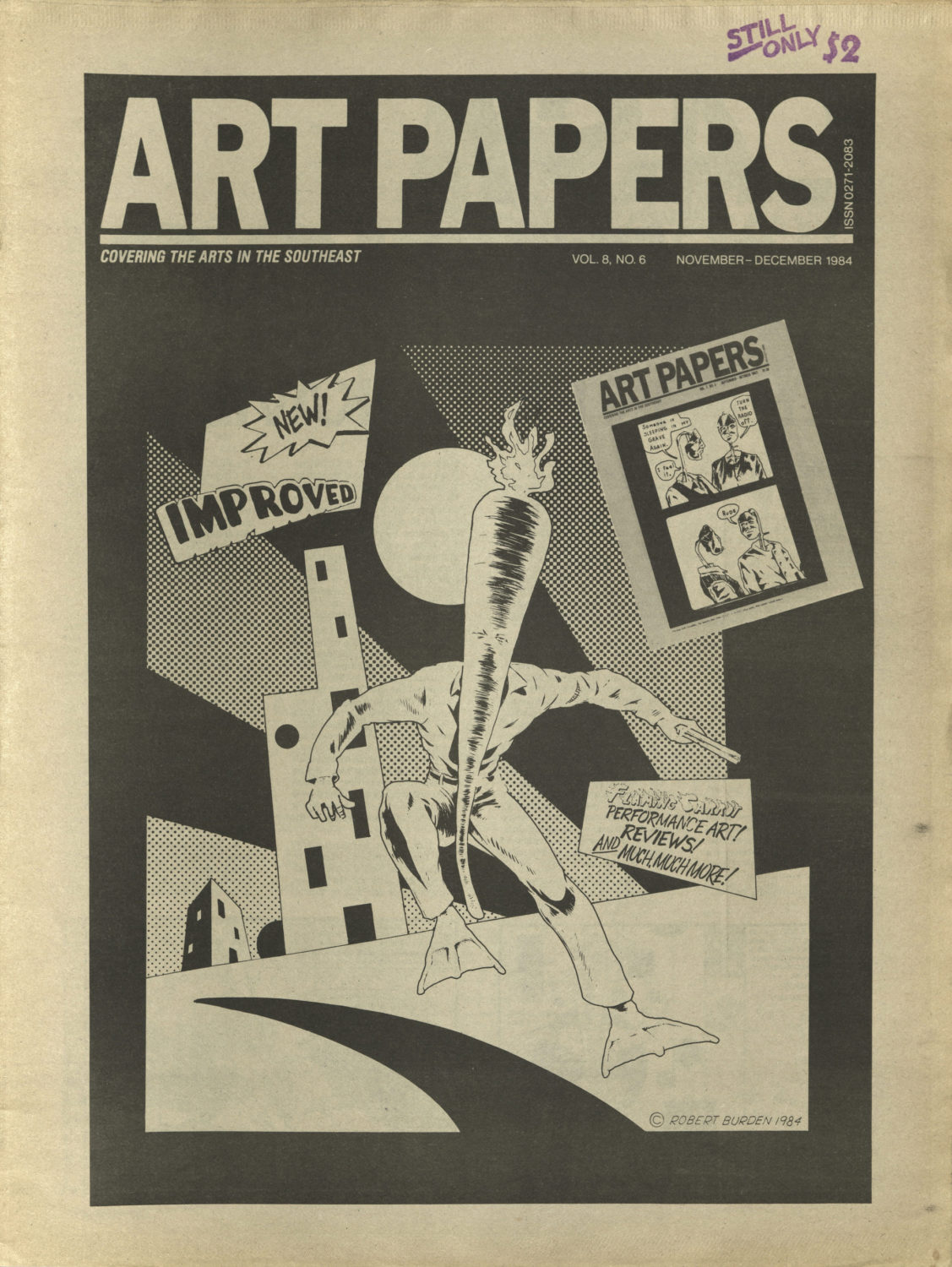
1984
Welcoming “1984”
Editor Laura Lieberman bade farewell to the magazine with an issue featuring an ironic study by Douglas DeLoach of the art of sports artist Leroy Neiman, alongside more characteristic contributions from activist critic Lucy Lippard, Fluxus legend Dick Higgins, and newly arrived Nexus curator Alan Sondheim. New Editor Xenia Zed arrived with an interview with video artist Dara Birnbaum, and coverage of the First Atlanta Biennale at Nexus, a project of Alan Sondheim which his successors have continued to the present day. A special issue with the Architecture Society of Atlanta included an extract of a work on Berlin by Alan Balfour, who would become a longstanding supporter of the magazine, and a review essay on “Kandinsky: Russian and Bauhaus Years” by Atlanta writer and scholar Jerry Cullum, who soon thereafter became a member of the magazine’s editorial staff. Volume eight concluded with a prominent cover story on the visual and conceptual accomplishment of Bob Burden’s Flaming Carrot comic books (see photo), a move which was reportedly held against the publication in a National Endowment for the Arts panel meeting a few months later.
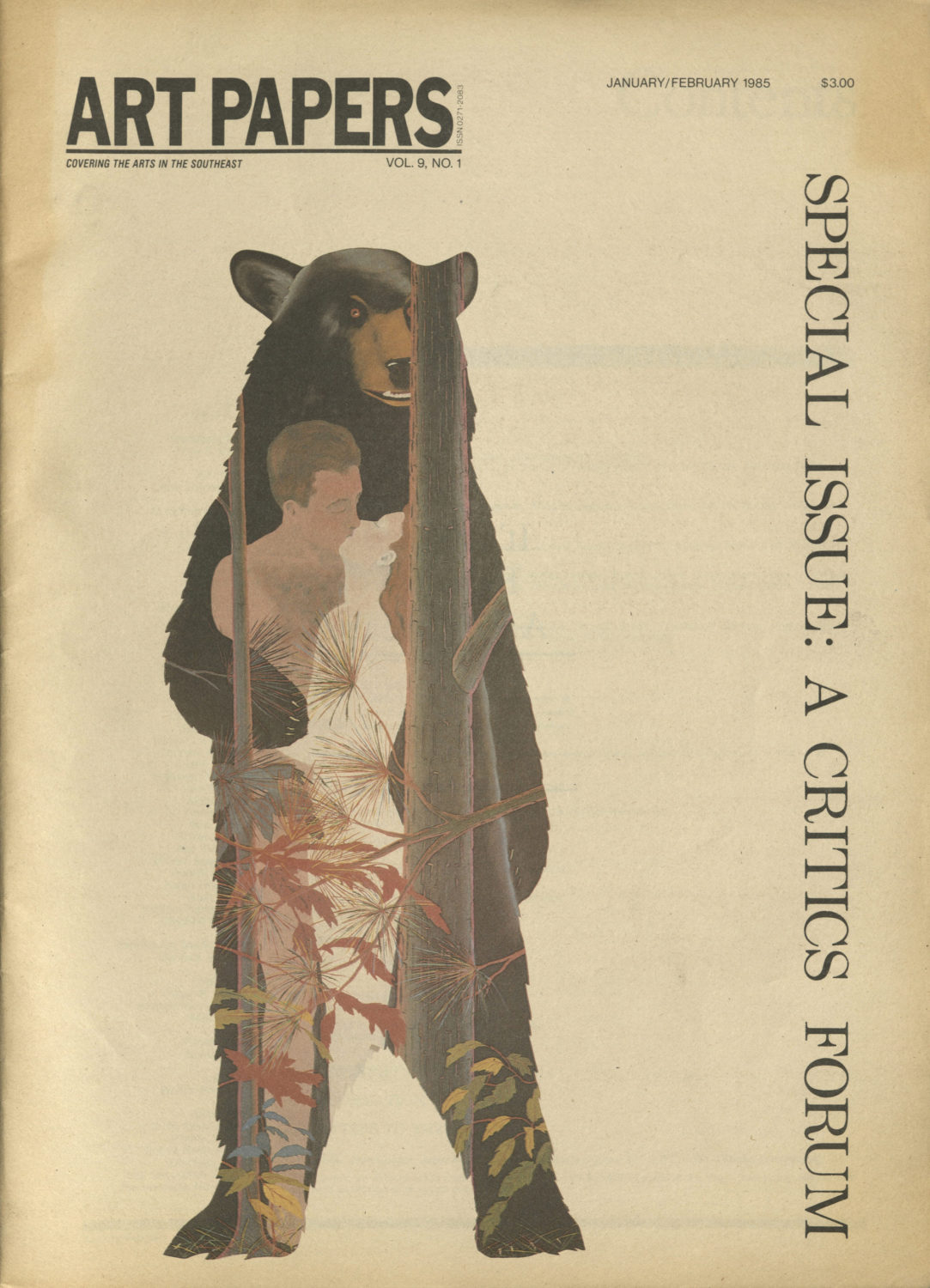
1985
A Critics’ Forum
After an NEA-funded critics’ symposium in October 1984 brought together regional and national critics to evaluate the condition of art in the Southeast, edited transcripts published in the January/February issue (see photo) of volume nine brought readers the passionately argued views of Christopher Knight, Roberta Smith, Thomas Lawson, Martha Rosler, and Donald Kuspit, together with an equally impassioned panel of regional writers. The New Media issue that followed was devoted to topics in art and science, a theme that would recur in subsequent years. That year also brought the first feature-length piece, on writer Kathy Acker, by a new contributor, Glenn Harper, who would become Editor of the magazine less than a year and a half later. “A/The Black Aesthetic,” the theme of the JANUARY/FEBRUARY issue, was an innovative exploration of a topic that would later be revisited from various perspectives. Contributors to that issue included Benny Andrews, AFRICOBRA member Wadsworth Jarrell, Lowery Stokes Sims, and an as yet little-known younger scholar named Henry Louis Gates.
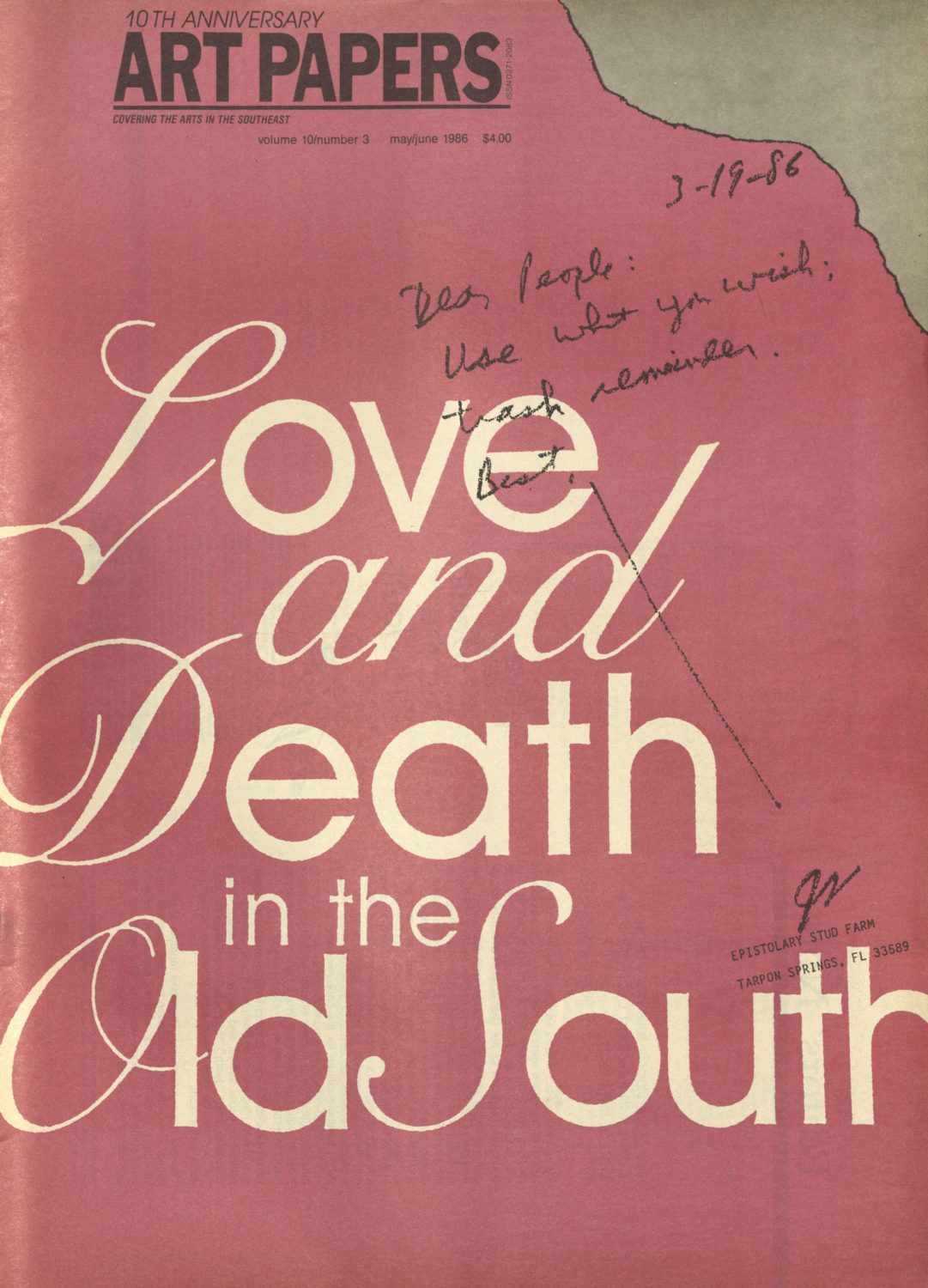
1986
The 10th Anniversary
Volume 10 kicked off with a compendium on a prevailing topic in the mid-’80s artworld, “The Crisis in Knowledge: Poststructuralism, Postmodernism, Postmodernity,” including essays by Jean-Francois Lyotard, Lucy Lippard, and then-emerging African-American scholar, Cornel West. The most sought after philosopher of the moment, Jacques Derrida, was interviewed by Robert Cheatham and Jerry Cullum. The postmodern theme recurred at year’s end with “Art and the Sacred in the Postmodern Era,” a title that was inspired by another magazine’s erroneous transcription of one of Lyotard’s book titles-which should have been “Art and the Secret in the Postmodern Era.” This collection of essays by Suzi Gablik and others included the only extract ever published of the fragmentary final volume of Mircea Eliadeâs History of Religious Ideas. By happy accident, the correct topic of “the secret” got its due in the title of “Architecture in the Land of the Secret Formula,” a special issue with the Architecture Society of Atlanta that was contained in a glassine envelope and printed as a sheaf of differently-sized leaflets and objects. “Love and Death in the Old South” (see photo) was the first of a sequence of issues devoted to artists’ pages. Another issue featured a survey of the rise of ironic neo-modernism.
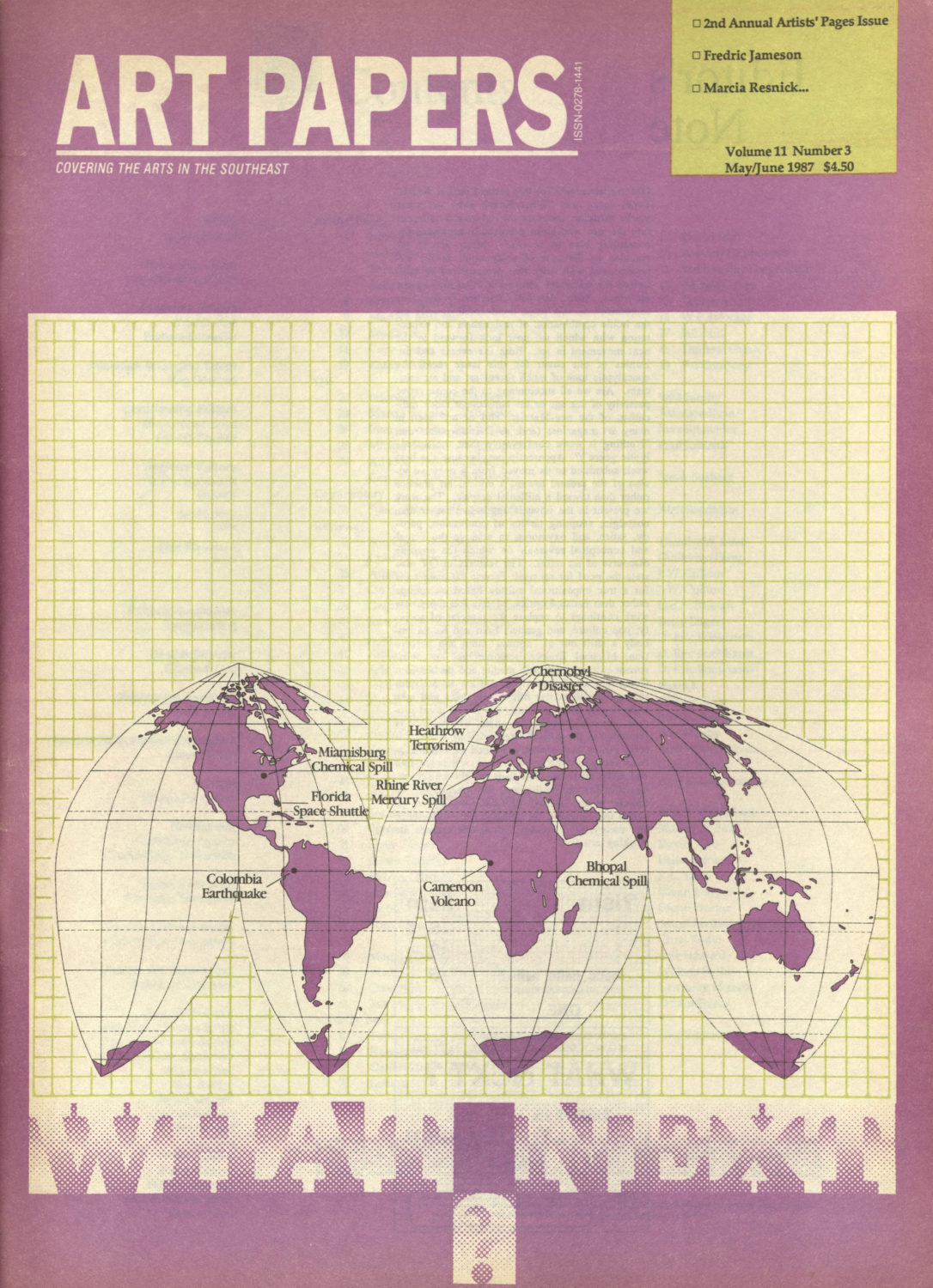
1987
The Feminist Issue
During her recent tenure, Editor Xenia Zed had dreamed of an all female issue, written exclusively by women, that would subtly appear without much fanfare. Though the issue was never realized, new Editor Glenn Harper decided to produce an issue on feminism but without limiting the content to female writers. The result was spirited and politically-oriented, a trend which would continue throughout Harper’s editorship, containing an interview with Barbara Kruger and an infamous Public Service Announcement by the Guerrilla Girls. Essays in volume 11 were loosely linked around themes—including the second Artists’ Pages issue (see photo), subtitled, “What Next?,” an issue with a focus on Art and Nature, which contained the magazines first contribution from past Chicago Contributing Editor Maureen Sherlock, and an issue which purported to survey the non-profit beast—-while containing the short-lived QV section of non-related feature material, the most notable being an interview with theorist Fredric Jameson. This year also saw the final collaborative issue with the Architectural Society of Atlanta, and the arrival of Mildred Thompson as a writer and interviewer.
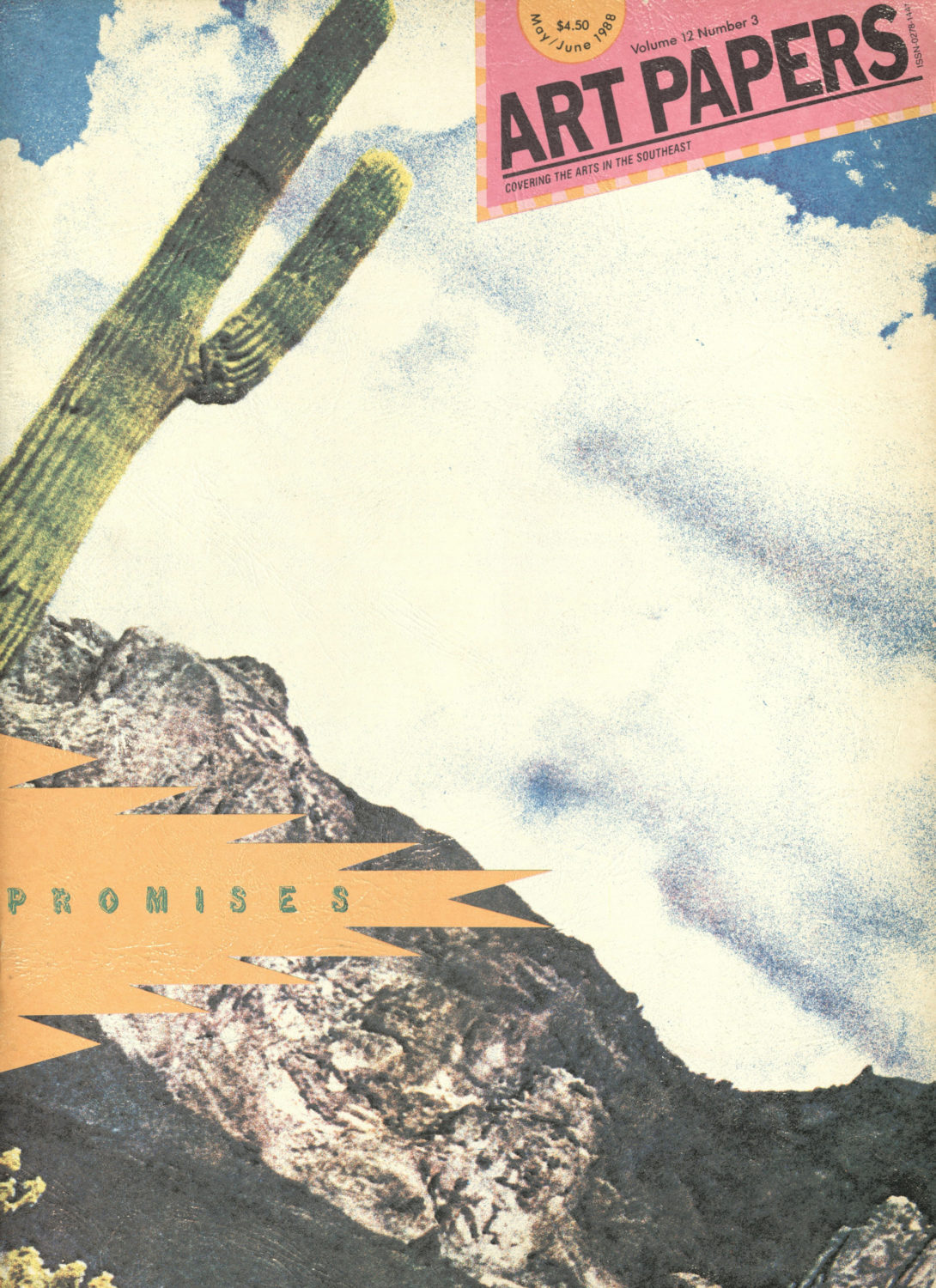
1988
Playing Hardball With The Big Boys
Although it was the theme of an issue which focused on art, taxes, politics and criticism, the magazine itself placed inside a cover printed on a large manila envelope. “Playing Hardball with the Big Boys” also symbolized the publications growth during volume 12 via hard-stock covers and increased production values throughout—this in addition to ART PAPERS’ credible reputation as a growing national publication. That year brought some inventive theme issues, including the third Artist’s Pages Issue (see photo), subtitled “Campaign Promises” in honor of the presidential election of that year, and issues on performance and art and funding. Glenn Harper’s editorship was now firmly in place, and a clear sense of consistent political involvement was emerging while the publication continued with some of the themes it had established earlier—such as Southern folk art, seen in a lengthy obituary for Minnie Evans, and African-American artists, which manifested as an entire issue on “Contemporary Black Artists.” Other articles of interest included interviews with Keith Haring and Group Material. Also of note was a special issue sponsored by the Southern Arts Federation, which contained an insert on the National Endowment for the Arts’ Documentary Photography Fellowships along with several essays on photography in the regular part of the magazine.
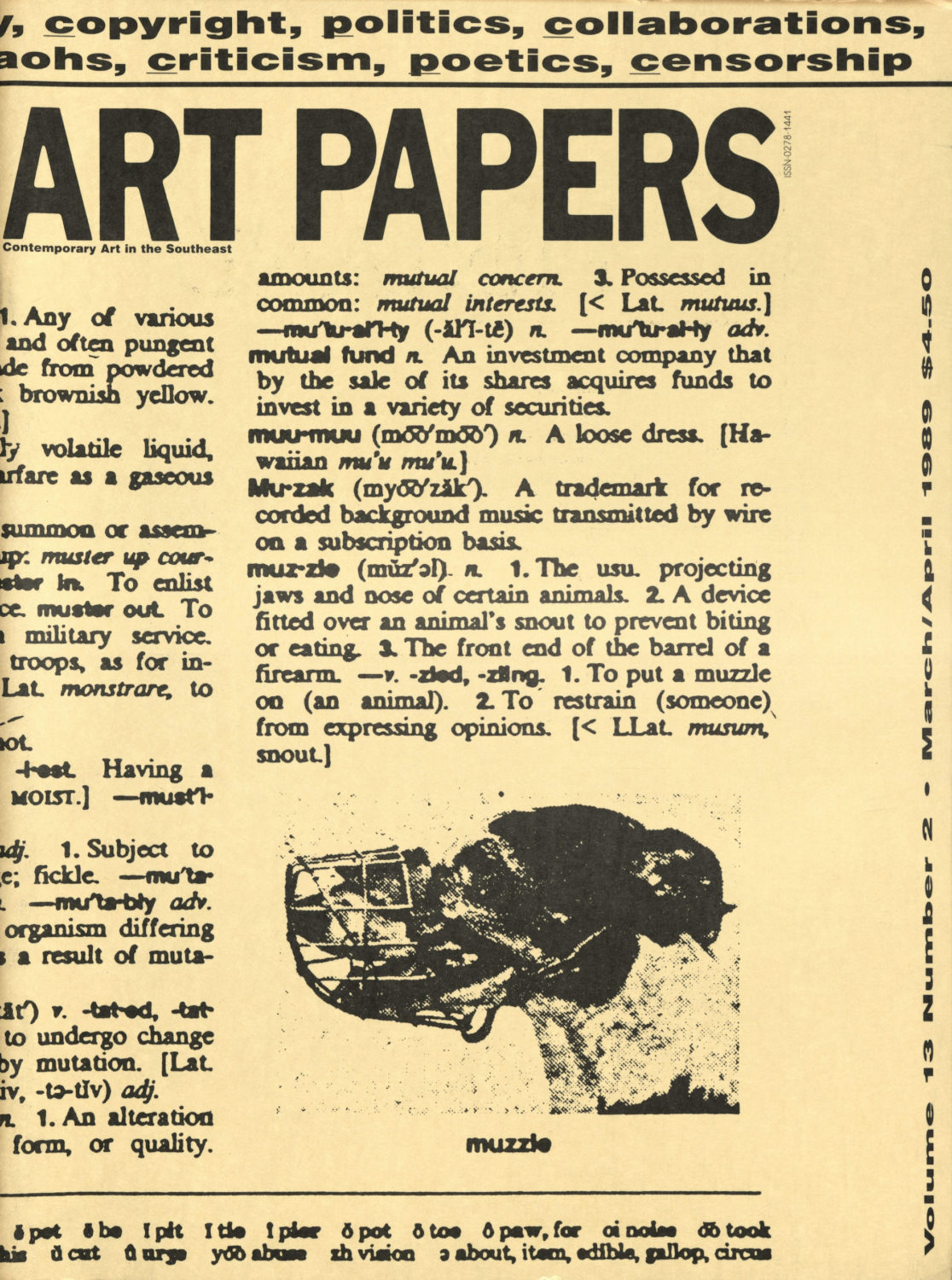
1989
The Baudrillard Interview
Volume 13 kicked off with John Johnston’s interview with Jean Baudrillard in an issue which also contained Fluxus artist Dick Higgins’ essay, “Five Myths of Postmodernism.” Other issues that year focused on film and video, sculpture, a special look at regionalism in addition to the annual artist’s pages issue. Controversial photographer Sally Mann was among those interviewed, as well as artists ranging from Native American sculptor Bob Haozous to conceptual artist Richard C., and artist Pat Courtney designed the cover of the March/April issue (see photo). Interviews with sculptors and installation artists such as Donald Lipski, Shirazeh Houshiary, and Athena Tacha, as well as a conversation with folk artist James “Son” Thomas and essays on the mobile home in America and Harris Dimitropoulos’ monument in Paris for the bicentenary of the French revolution rounded out the year.
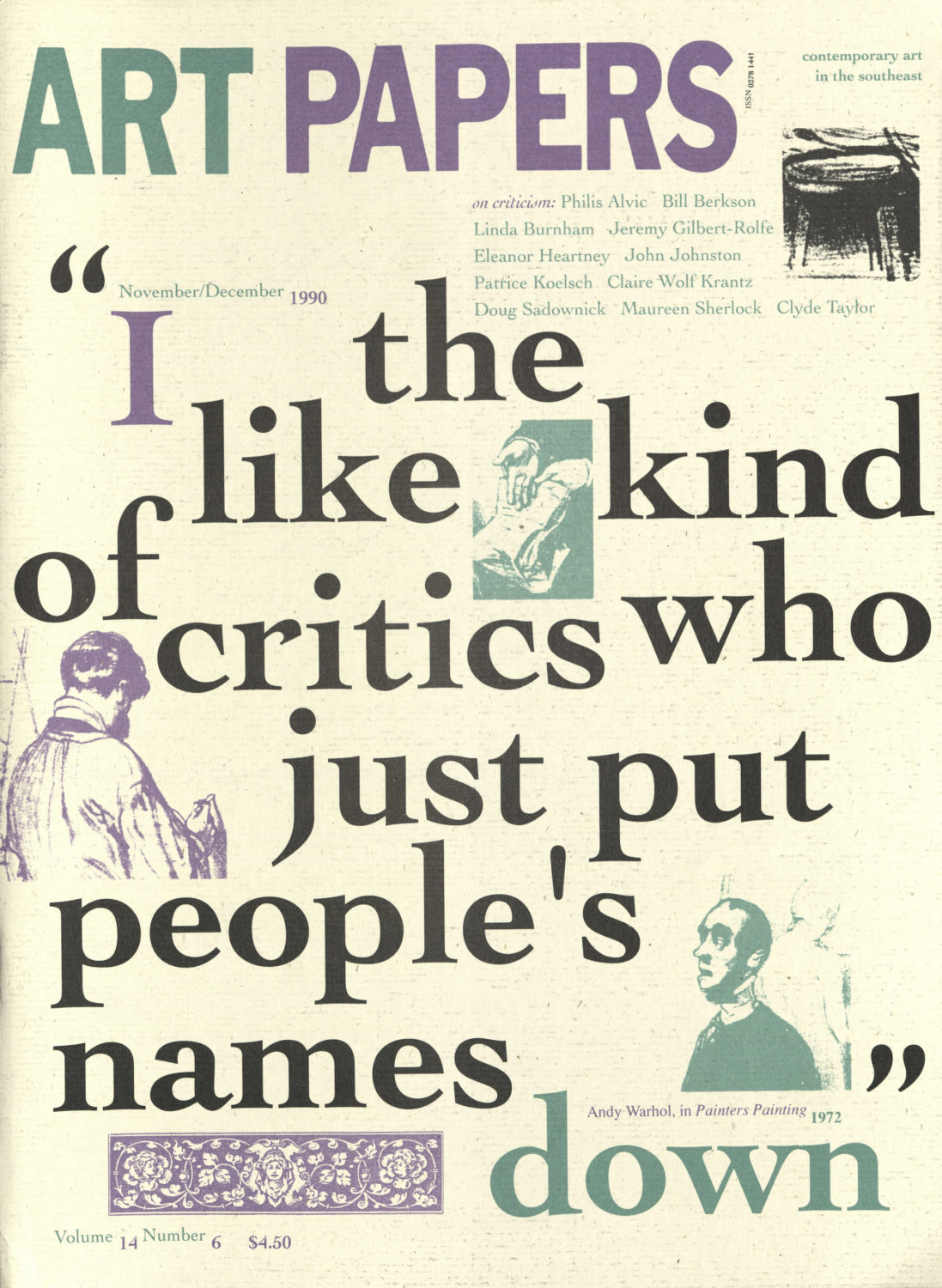
1990
Noise Culture
Guest Edited by frequent contributor Alan Sondheim, the “Noise Culture” issue delved into the world of zines and club culture, even containing a special zine insert. The issue also contained an interview with Atlanta’s own Ru Paul, who was then on the cusp of celebrity status. Of particular note was an article on art in Berlin at the time the Berlin Wall came down. Other issues in volume 14 included a second collaboration with Nexus Press on artist’s books, with a cover designed by Ruth Laxson, and an issue on black artists containing articles by theorist bell hooks and artist Adrian Piper. The magazine’s first issue on art and education also appeared, a theme that would continue to be revisited in later years. Ending the volume was an issue on art criticism (see photo) with articles by Jeremy Gilbert-Rolfe and Eleanor Heartney.
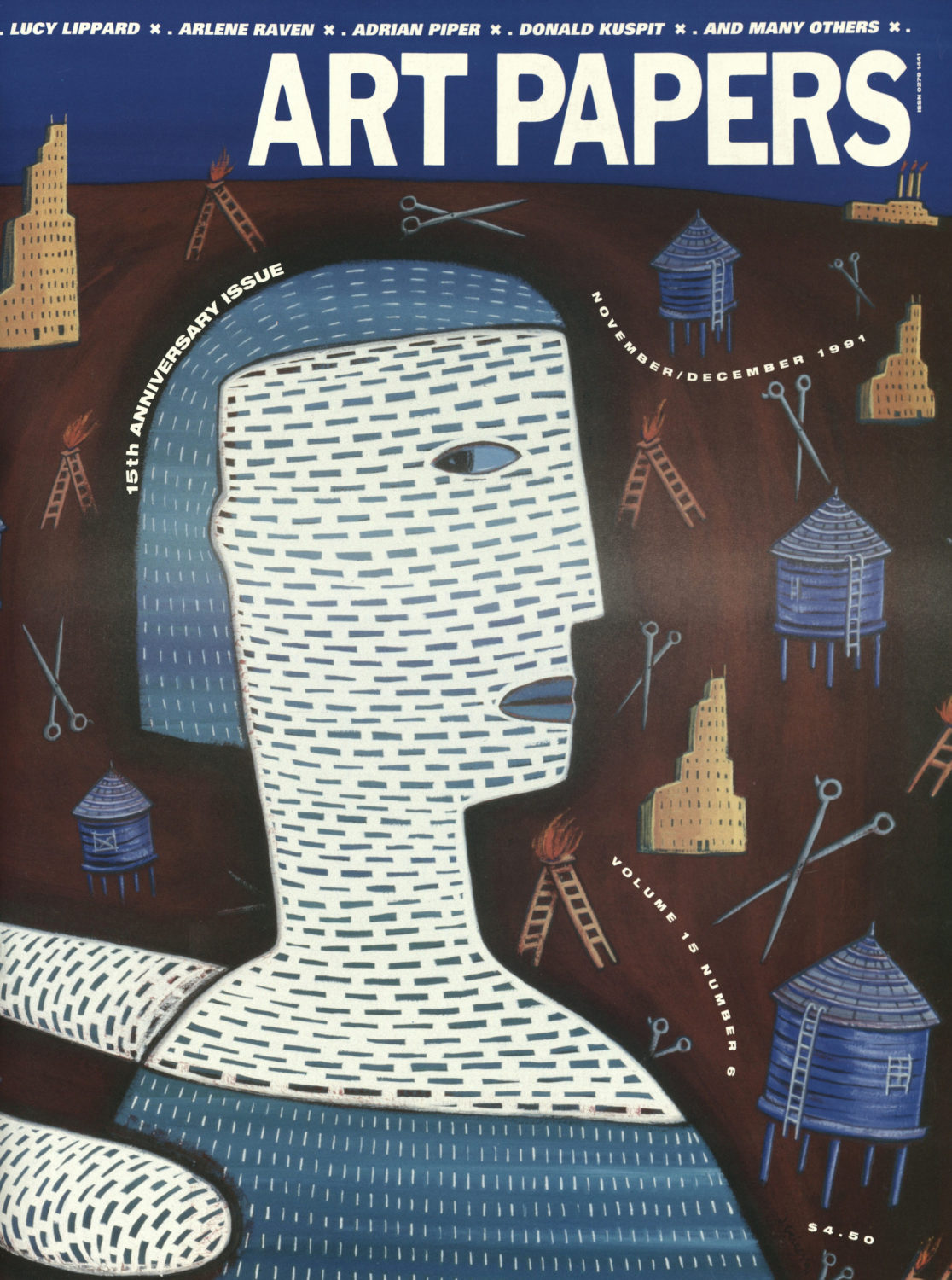
1991
The 15th Anniversary
After a decade and a half of publishing, Art Papers under Glenn Harper’s editorship had arrived as a national art journal of prominence, routinely featuring well known artists alongside emerging ones and a similar range of writers. Volume 15 contained some of the magazine’s most interesting contents, including interviews with artists Keith Sonnier, Philip Glass, Chris Burden, Christian Boltanski and Ann Hamilton, curators Collins and Milazzo, and folk artist George Andrews. Articles included censorship and public art, a timely topic in relation to the NEA culture wars, and special issues on Mail Art and the Alternative Arts Press. The latter issue, in particular, proved that the publication was among a handful of enduring non-profit journals of note along with Art Issues and New Art Examiner. Other publications featured in that issue, such as the Minnesota-based Art Paper, contributed daunting accounts of why they went out of business-almost as a warning to the remaining members, and readers of, the alternative arts press. The year concluded with a special 15th Anniversary issue (see photo). Funded by the Warhol Foundation, the issue featured contributions from former editors and writers, as well as reprints of some of the most provocative and still relevant articles from the magazine’s past.
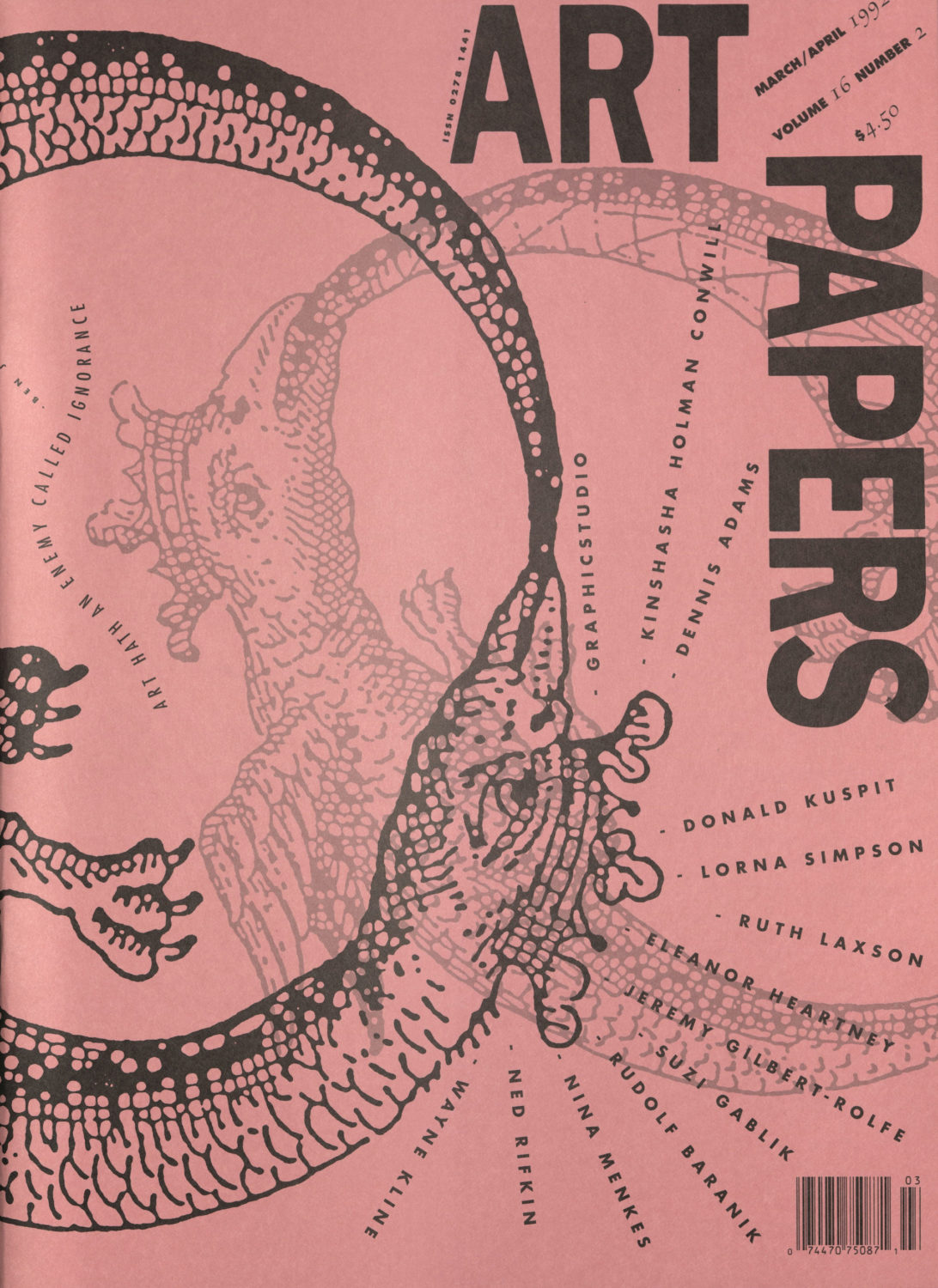
1992
The Craft Issue
Volume 16’s comprehensive survey of topics in craft arts, from Dale Chihuly to Nigerian adire cloth, was one of the few issues of 1992 not to be guest edited—a practice with which Editor Glenn Harper achieved greater diversity of content. Guest edited issues included current Contributing Editor Maureen Sherlock’s “Bifocal Borders,” on the notions of cultural as well as geographical border questions, Deborah Willis’ “Photobiographers,” a survey of African-American photographers, and Cindy Patton’s “Boundary Crossings,” which returned to Sherlock’s theme of borders and boundaries but this time bringing in the dividing lines in gender issues and ethnicity. And Chicago’s Randolph Street Gallery collaborated on “Counter Proposals: Adaptive Approaches to a Built Environment,” including a feature story by their gallery director at the time, Inigo Manglano-Ovalle. The remaining issue of the year (see photo), which contained symposium transcriptions from a lecture series at the Atlanta College of Art titled “Art in Context: Public and Private Values,” was printed on varying colors of cover stock that the magazine’s printer had offered at a significant discount. The resulting five versions of the cover added an alluring air of intrigue and collector value which contrasted nicely with the publication’s grass roots origins.
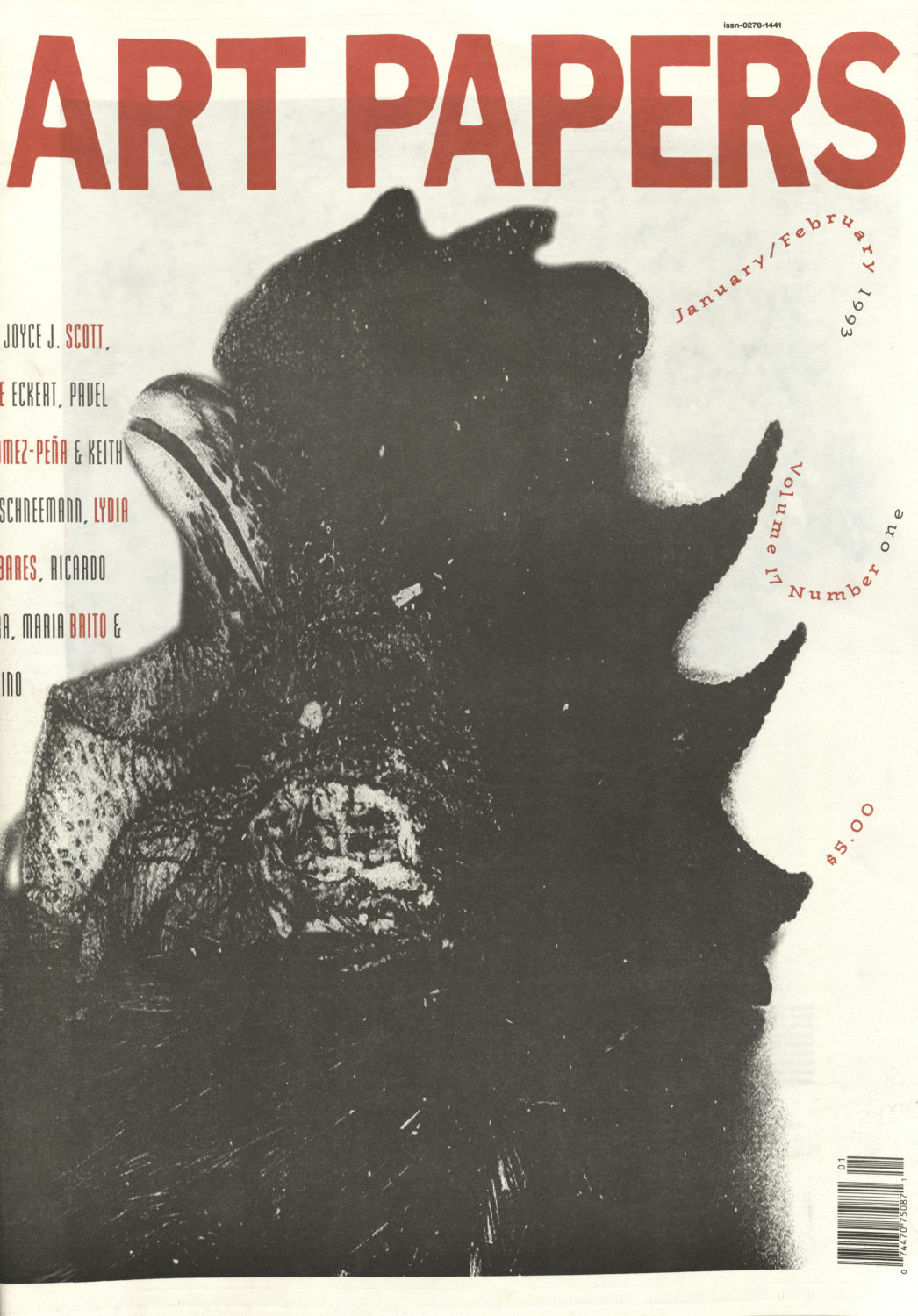
1993
A Dead Rooster On The Cover
A feature story in volume 17 on the performance art of Guillermo Gómez-Peña, which prominently featured a deceased chicken, led to a memorable moment of copier art in which Editor Glenn Harper and Designer Elizabeth Lide collectively balanced a dead rooster on the glass plate of a photocopier, producing one of the more startling Art Papers covers (see photo) of the first half of the 1990s. More unexceptionably, a work by the European architecture collective Coop Himmelblau graced the next cover, and a feature on Lonnie Holley marked a continuing concern with Southern folk art. Other issues that year included a symposium on “The Spectacle of Culture in Museums” that featured Fred Wilson at the height of his “Mining the Museum” fame in conversation with anthropologist Ivan Karp. “The Antemillennium Dollhouse” was a competition sponsored by the magazine that provoked the imaginations of architectural students to the design of dollhouses that addressed major issues of dwelling or housing.
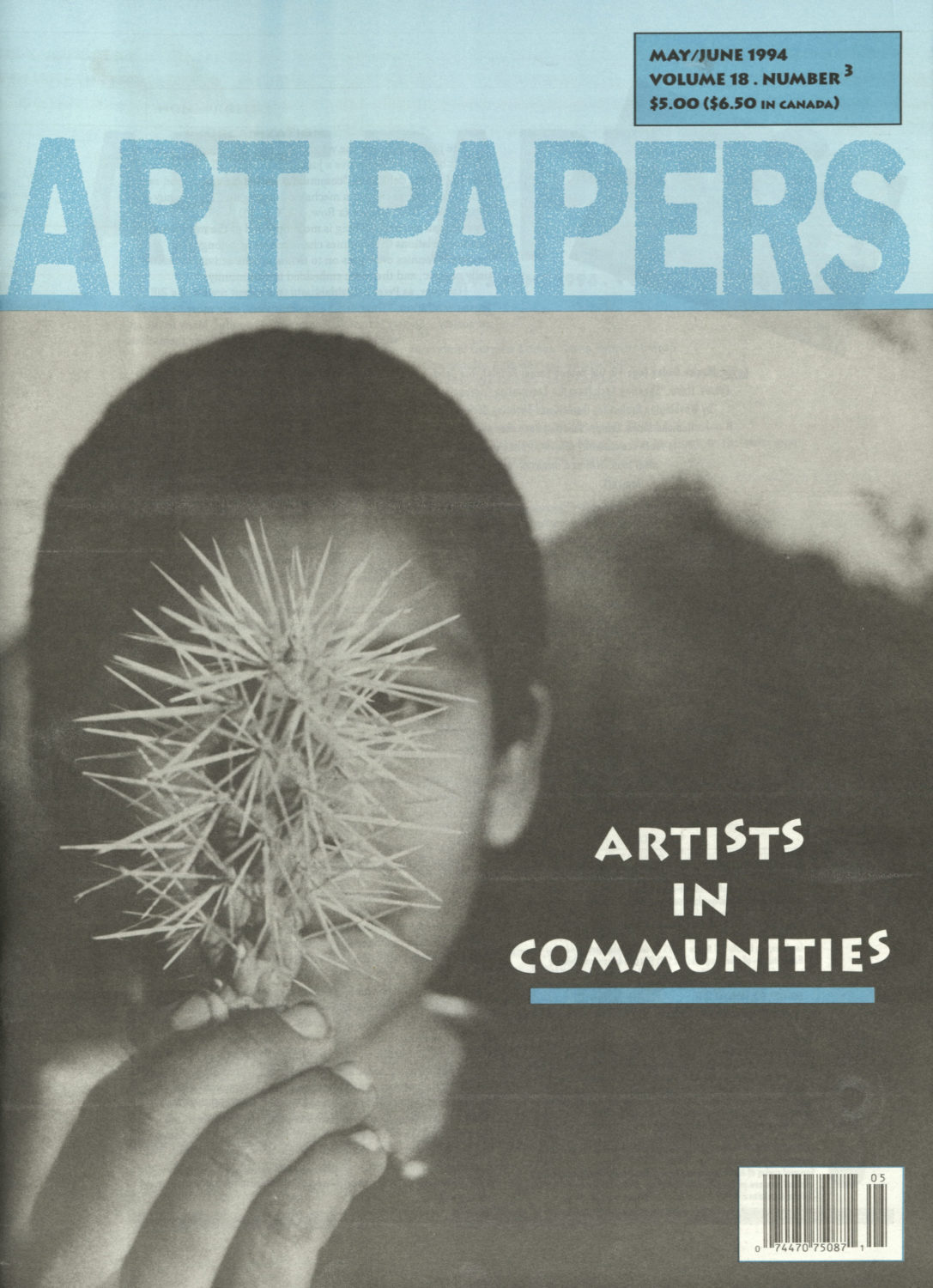
1994
Lesbian Subjectivities
Guest edited by Patricia Cronin, “Rethinking Lesbian Subjectivities” brought to the fore a genre of visual art that provoked and continues to provoke much controversy. The rest of volume 18 was calm by comparison, discussing “Artists in Communities” (see photo), continuing a focus on African-American artists through interviews with Alison Saar and Renee Stout, and offering such unexpected moments as an interview with glass artist Harvey Littleton. A series of interviews by Anne Barclay Morgan with major art critics also got underway, featuring discussions with Eleanor Heartney, Peter Schjeldahl, and Robert C. Morgan. A special issue on self-taught and outsider artists proved to be one of the most popular of the year, eliciting single-copy orders long after its run on the newsstands was over.
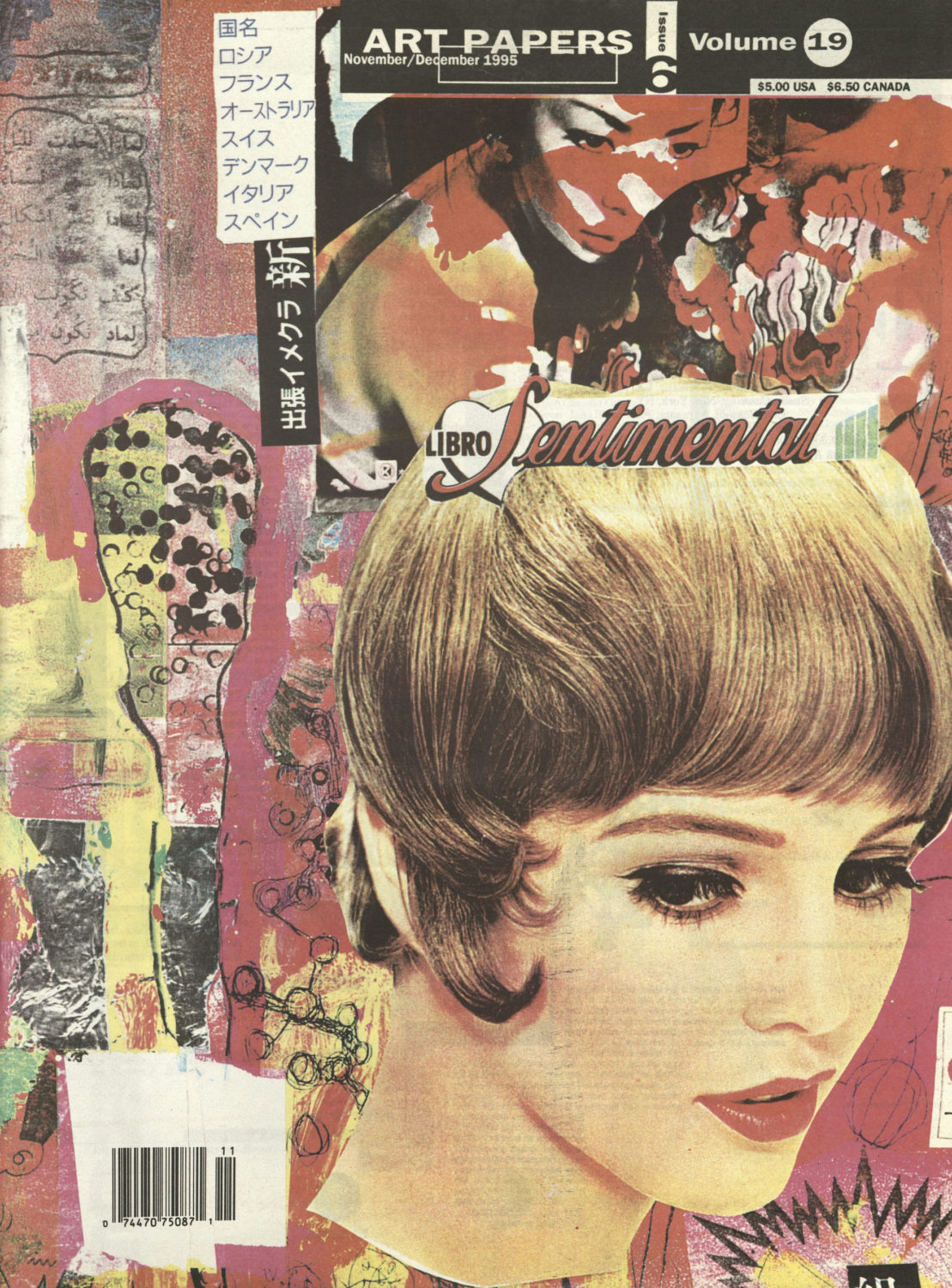
1995
No Alternatives
An interview with Japanese book artist Shinro Ohtake (see photo) launched the magazine’s coverage in volume 19 of the multi-year Cultural Olympiad, for which Atlanta’s Nexus Press produced five books by international artists from each of the five geographic areas represented by the Olympic rings-the Centennial games preparing to be held in Atlanta the following year. The rise of computer art and the Internet was explored by guest editor Alan Sondheim in an issue on “Future Culture,” a topic the magazine would begin addressing more regularly, while an ongoing interest in art and education was reflected by an issue dealing with art schools. Another historic theme for the publication, the crisis of underfunded and freshly marginalized alternative spaces, was considered in an issue titled “No Alternatives?” that defiantly declared the intention of alternative institutions to stay in business and suggested the possibility of such spaces going online.
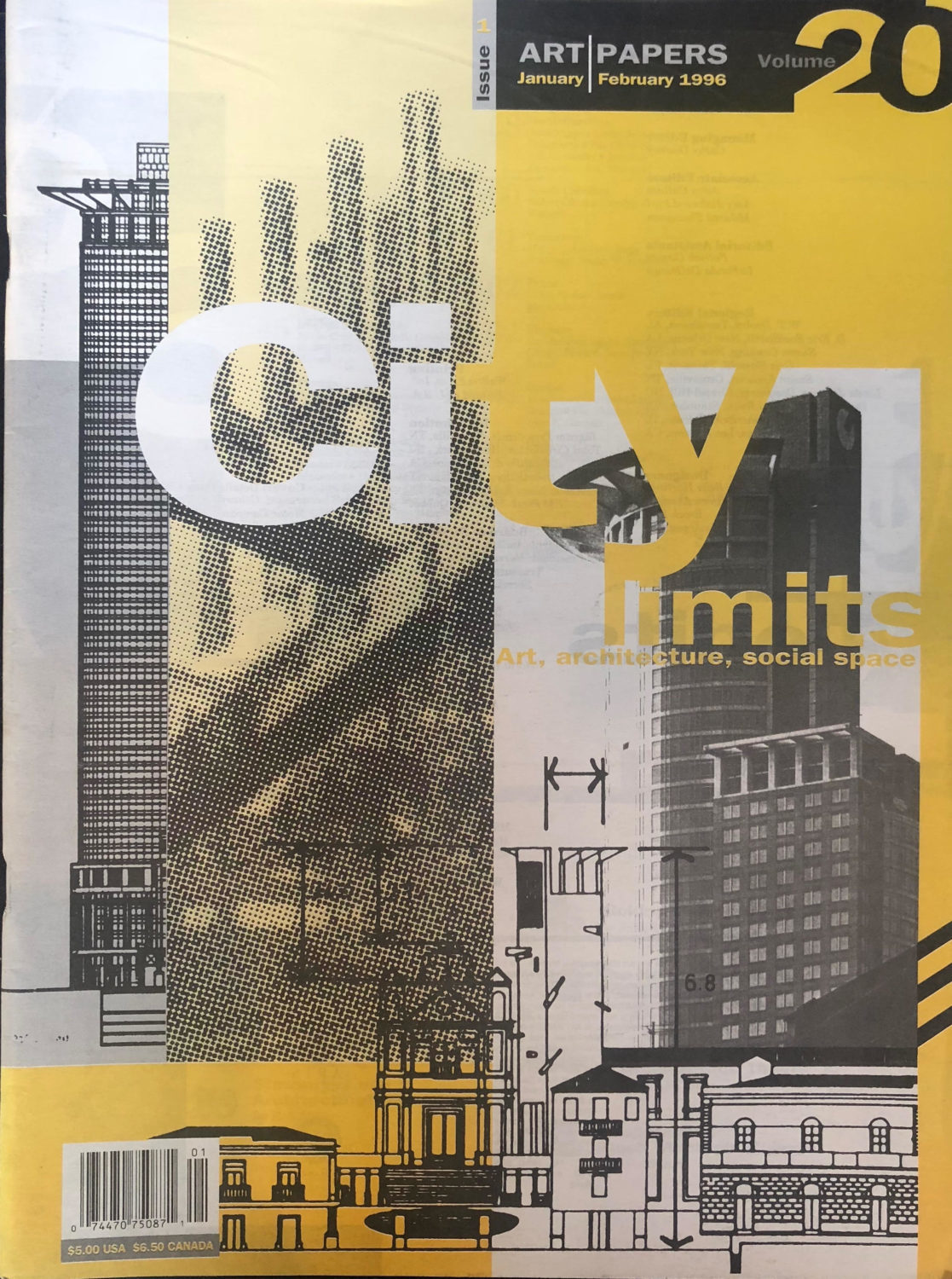
1996
The Cultural Olympiad
A full range of mainstream and marginal visual arts and performance accompanied the Centennial Olympic Games in Atlanta, and the magazine offered extensive coverage throughout volume 20 of everything from Siah Armajani’s tower and cauldron to the Taboo collective’s sendup of the hoopla surrounding Southern identity. An issue featuring international and Southern artists’ pages was on the streets for the Games themselves. Issues before and after explored topics from “City Limits,” a return to topics of architectural and social space, to the “Artist’s Survival Guide,” an issue dealing with practical questions that was so popular with working artists that it became the basis for a column that continues to the present day under the title “Surviving.” “Re-defining the Nineties” included interviews with Hal Foster and Thomas McEvilley on the elusive topic of how the decade was shaping up just past mid-point. Three of the year’s six issues were edited by individual staff members Cathy Downey, Jerry Cullum, and Amy Jinkner-Lloyd after the departure of Glenn Harper, who left the magazine to become Editor of the Washington-based publication, Sculpture.
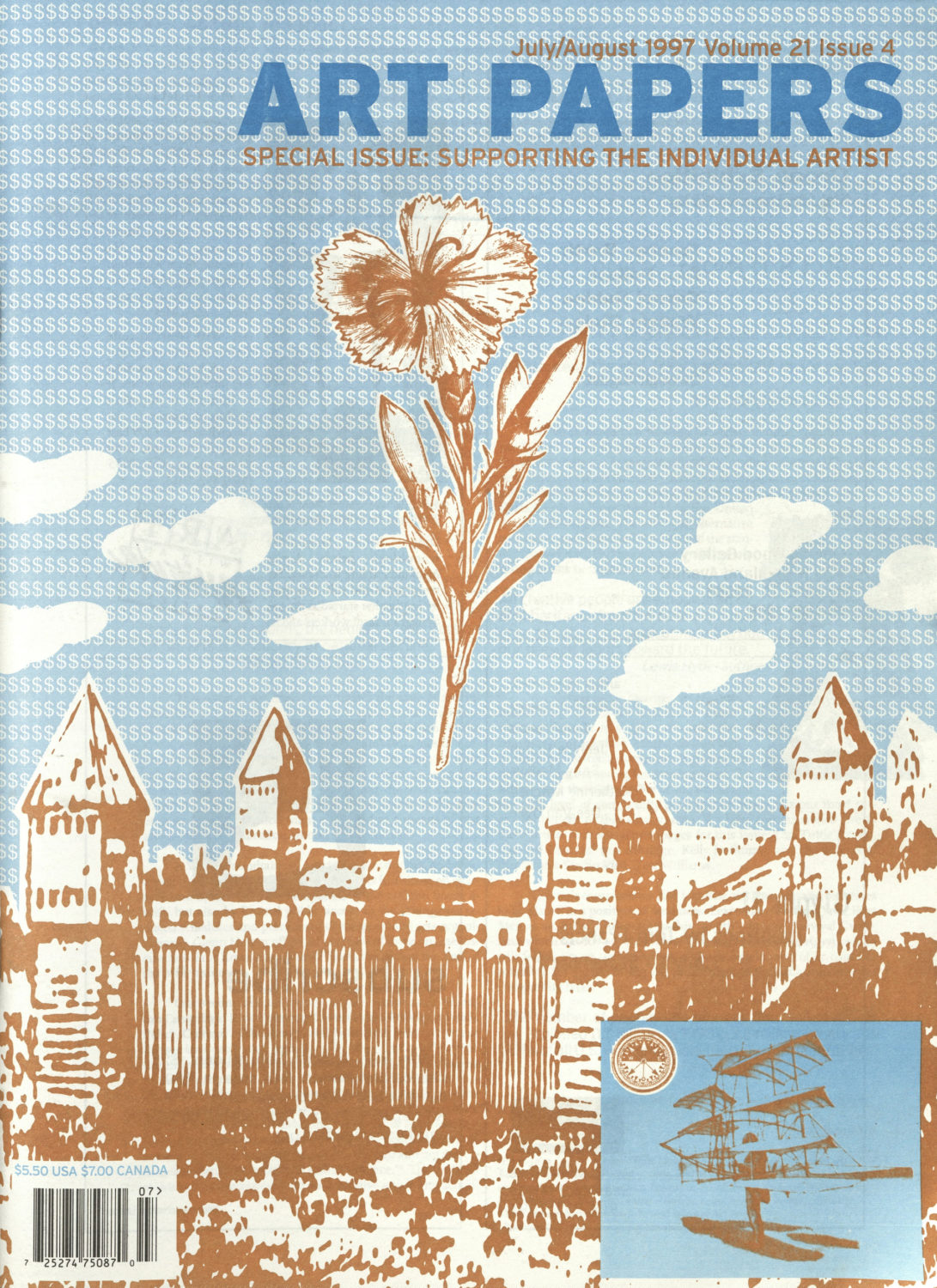
1997
Art and Advocacy
New Editor Ruth Resnicow’s brief tenure during volume 21 focused largely on funding and the survival of the arts, with three issues providing a comprehensive look at politics, public art, residencies and a host of other topics contributing to the general subject. Within these issues, original cover art by artists Lisa Tuttle (see photo) and Leslie Bellevance provided striking visual aesthetic moments, while then-Associate Editor Michael Pittari’s first feature article for the magazine appeared in the form of an interview with painter/video artist Cheryl Donegan. Other theme issues that year—different than in previous years in that all of the magazine’s content, except for reviews and news briefs, was dedicated to a given topic-focused on “The Curio Cabinet,” “Artist’s Books: Print Era and After,” and “Cultural Ownership.” The latter, in particular, was a seminal issue in moving the direction of the magazine towards globalism and cultural hybridity, with articles by Gerardo Mosquera, David Mura, and Olga Viso, as well as cover art by Jose Bedia. This year also saw the introduction of two regular columns: Studio Visit, devoted to the work of an emerging artist of note, and the Artistsâ Survival Guide, offering practical advice for working artists.
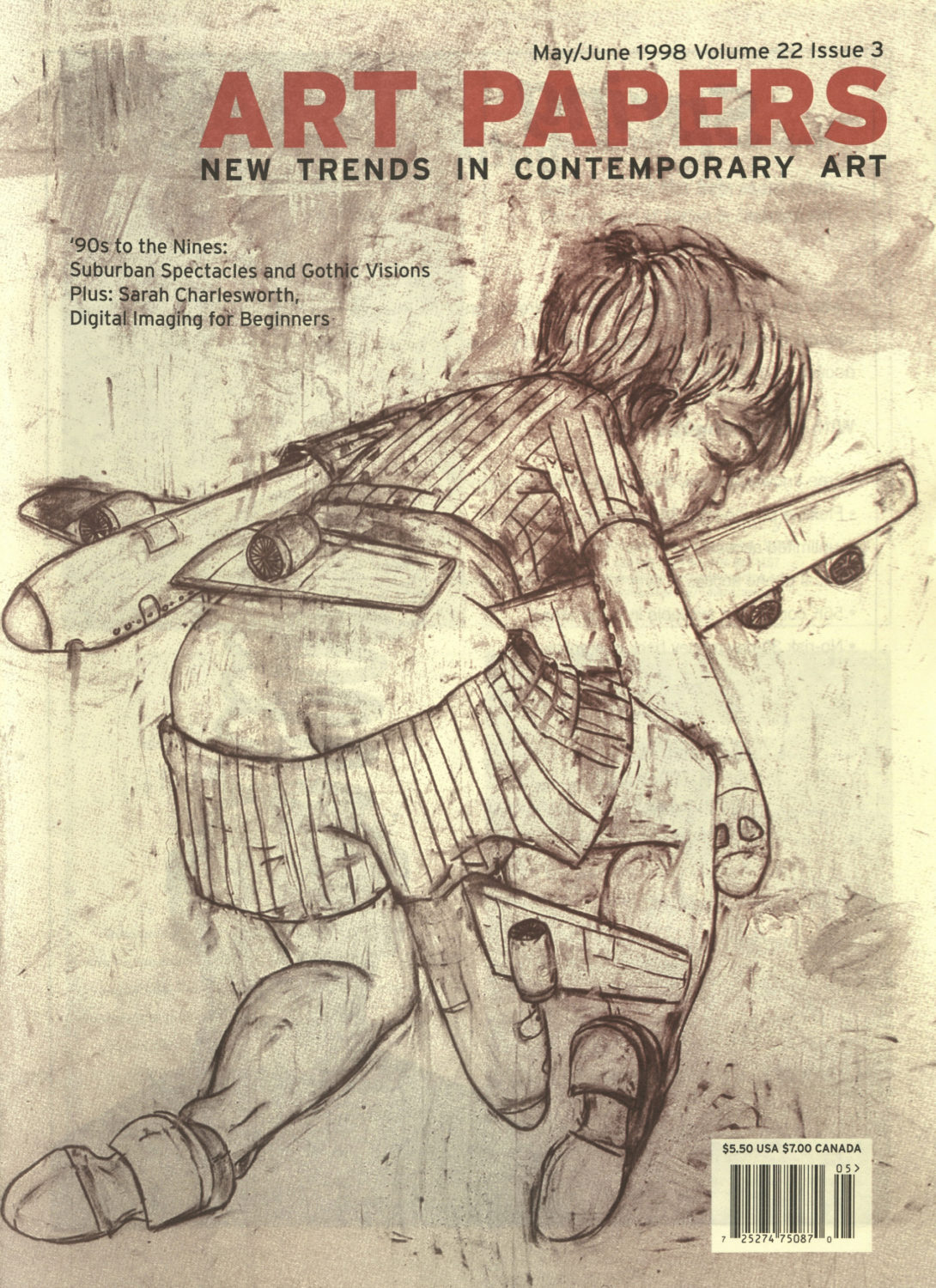
1998
Toward a New Art World
Under new Editor Michael Pittari, volume 22 continued the all-theme focus begun by Ruth Resnicow the previous year but with an editorial direction that was not so much a break from the magazine’s past as much as an embrace of the changing issues in contemporary art. The year began with an issue guest edited by Senior Editor Jerry Cullum, “Re-thinking Folk Art,” which epitomized the new direction for its global view of self-taught art, and continued with a more traditional issue on “The Future of Alternative Spaces.” “New Trends in Contemporary Art” (see photo) broke new ground through explorations by Contributing Editors Maureen Sherlock and Dinah Ryan on suburban and gothic art aesthetics, and an issue on “Education in the Arts” addressed K-12, college and museum art education while discussing technology and digital culture as new components of learning. The September/October issue, “Art and Film,” contained an interview with David Lynch in addition to articles on Peter Greenaway and the painterly aesthetics of Jean-Luc Godard. That issue also saw the inclusion of a new column, “In,” on international art scenes. The year concluded with “Art, Identity, Stereotypes,” an issue which re-visited many of the themes of 1997’s “Cultural Ownership” with some humorous twists.
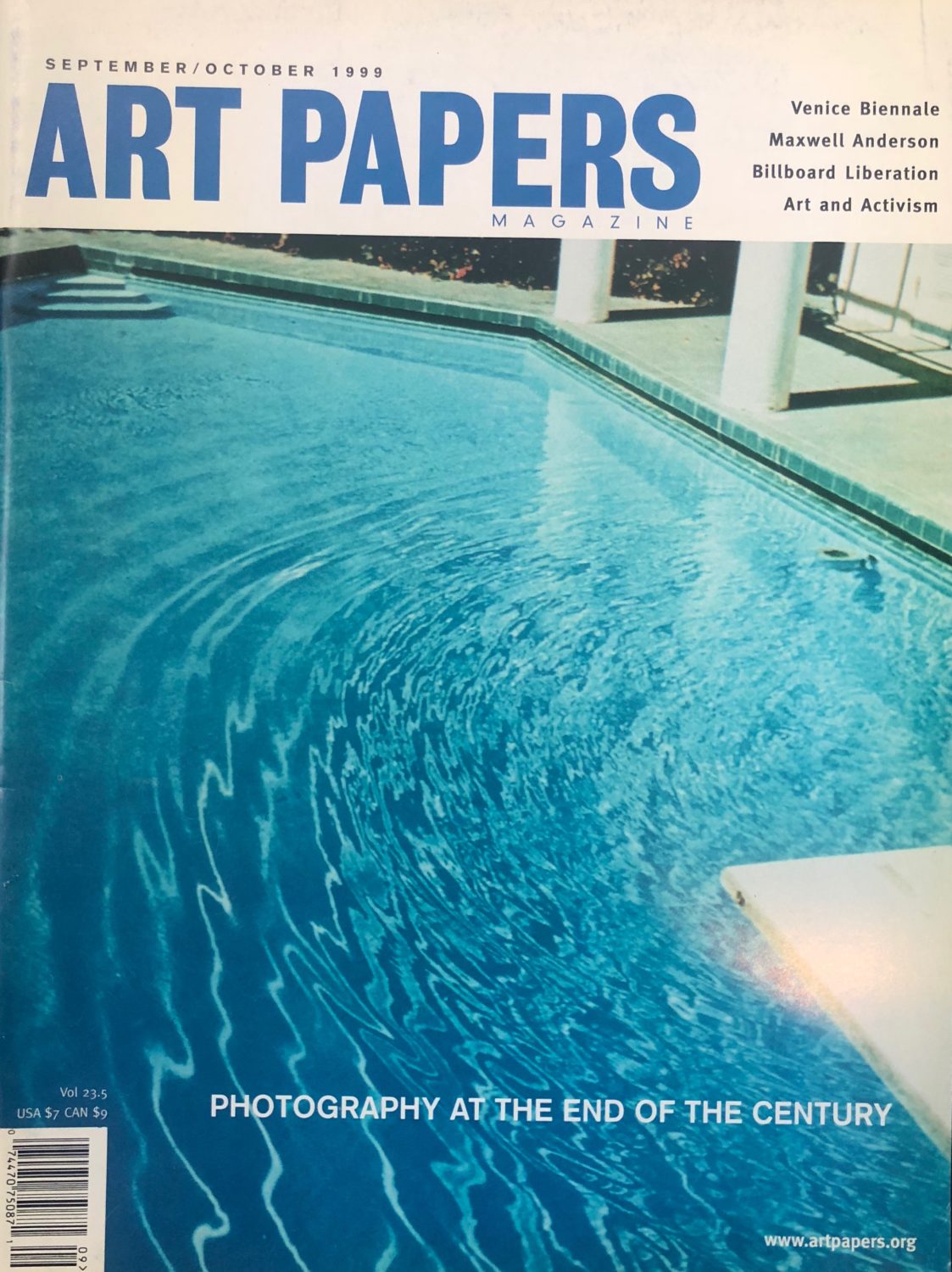
1999
Art at the End of the Century
Introducing the current Art Papers logo, volume 23 focused on a variety of subjects at the crossroads of art and culture. An issue on “Art and Science” explored this prescient topic at length, while “The New Language of Music,” the last all-theme issue, took the magazine into territory previously unexplored in such depth. Beginning with the May/June issue-containing the first hard-stock cover since earlier that decade, and the first interior color since well before-the publication began the current practice of running a major article along with features on other topics and an expanding array of columns such as Departures and Surviving, the latter an evolved and more anecdotal Artists’ Survival Guide. Cover stories such as “Painting at the End of the Century,” “Photography at the End of the Century,” and “Apocalyptic Cinema” were thus balanced by articles on topics such as performance art, art and activism, conceptually-oriented ceramics, the paintings and drawings of Hermann Hesse, and Chinese painter Chen Ping. Interviews included artists David Reed and Liza Lou, as well as Whitney Museum Director Maxwell Anderson and noted Surrealism authority Mary Ann Caws. While the magazine continued its expansion of the review section to encompass much of the U.S., individual reviews now categorized by region rather than the previous alphabetical listing, the In column focused abroad on some of the hotbeds of art today, including Berlin, Venice, Bilbao, Paris, Belfast and Havana.
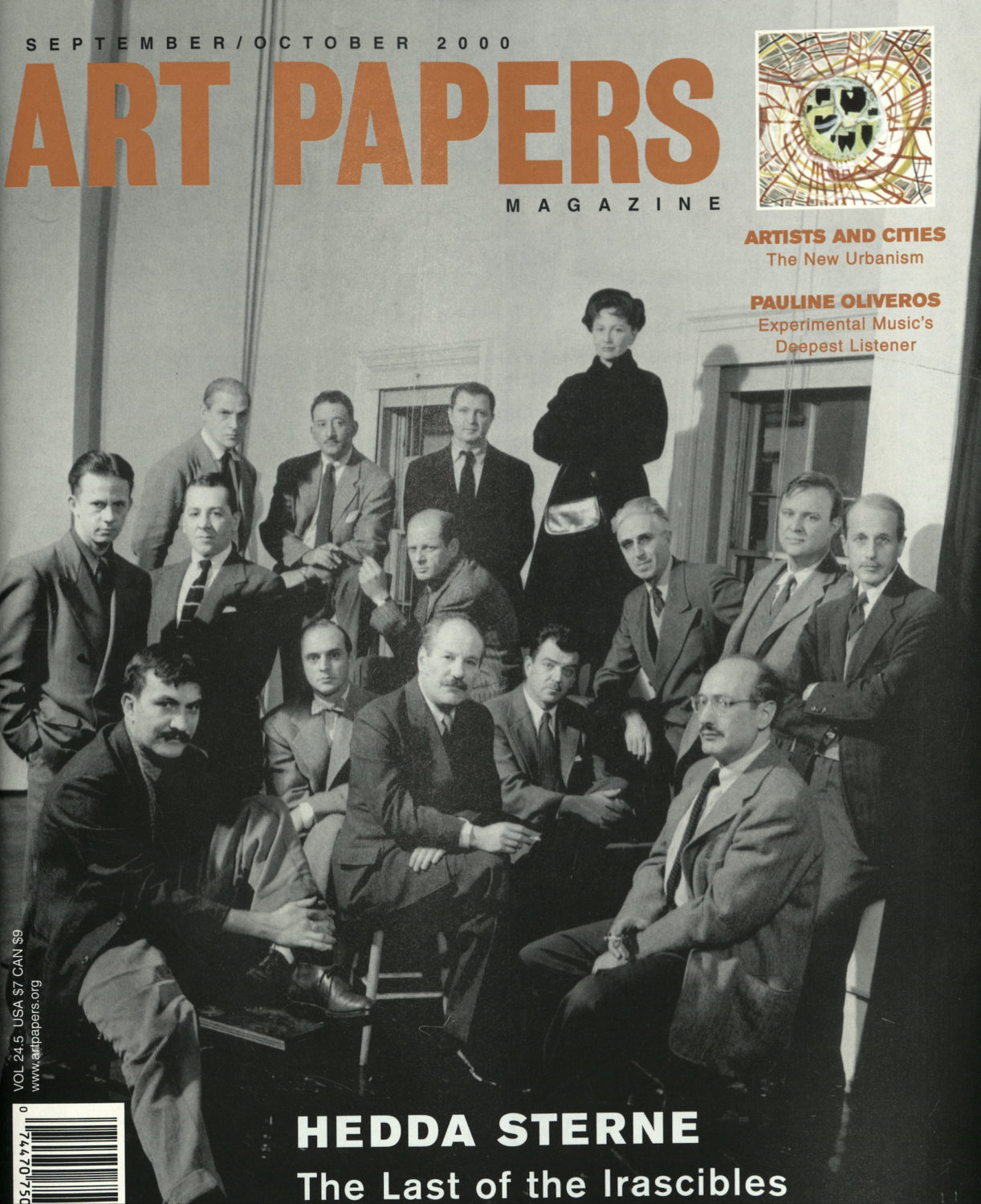
2000
A New Format
Volume 24 saw a dramatic change in the magazine, as increased printing costs made the switch to a smaller size format an economic necessity. While some missed the tabloid-size which the publication had maintained since volume two, the new format gave Art Papers increased distribution possibilities, thus beginning the first significant expansion of readership in many years. The year began with a 25-year survey and interview with Laurie Anderson, one of the first “Artist to Artist” contributors back in 1979 along with John Turturro, and a travelogue from Japan on the dance-art form Butoh. That issue also introduced the Soundbytes column, in which Patrick Hughes has written regularly on innovative musical forms. The following issue included an essay by historian Robert Rosenblum on the Norman Rockwell Retrospective, for which the magazine designed a special cover mimicking the Saturday Evening Post, and an interview with Maya Lin. Other issues covered topics including extended adolescence in contemporary art, 30 years of conceptual art, Radcliffe Bailey’s “Magic City” exhibition, and a group of Chinese expatriate artists including Muna Tseng and her deceased brother, Tseng Kowng Chi. Interviews were conducted with critic Dave Hickey, artist Richard Misrach, and composer/musician Pauline Oliveros, while the surprise of the year was Mary Ann Caws’ tribute to Hedda Sterne, the lone female and surviving member of the infamous “Irascible Eighteen” group of Abstract Expressionist painters (see photo).
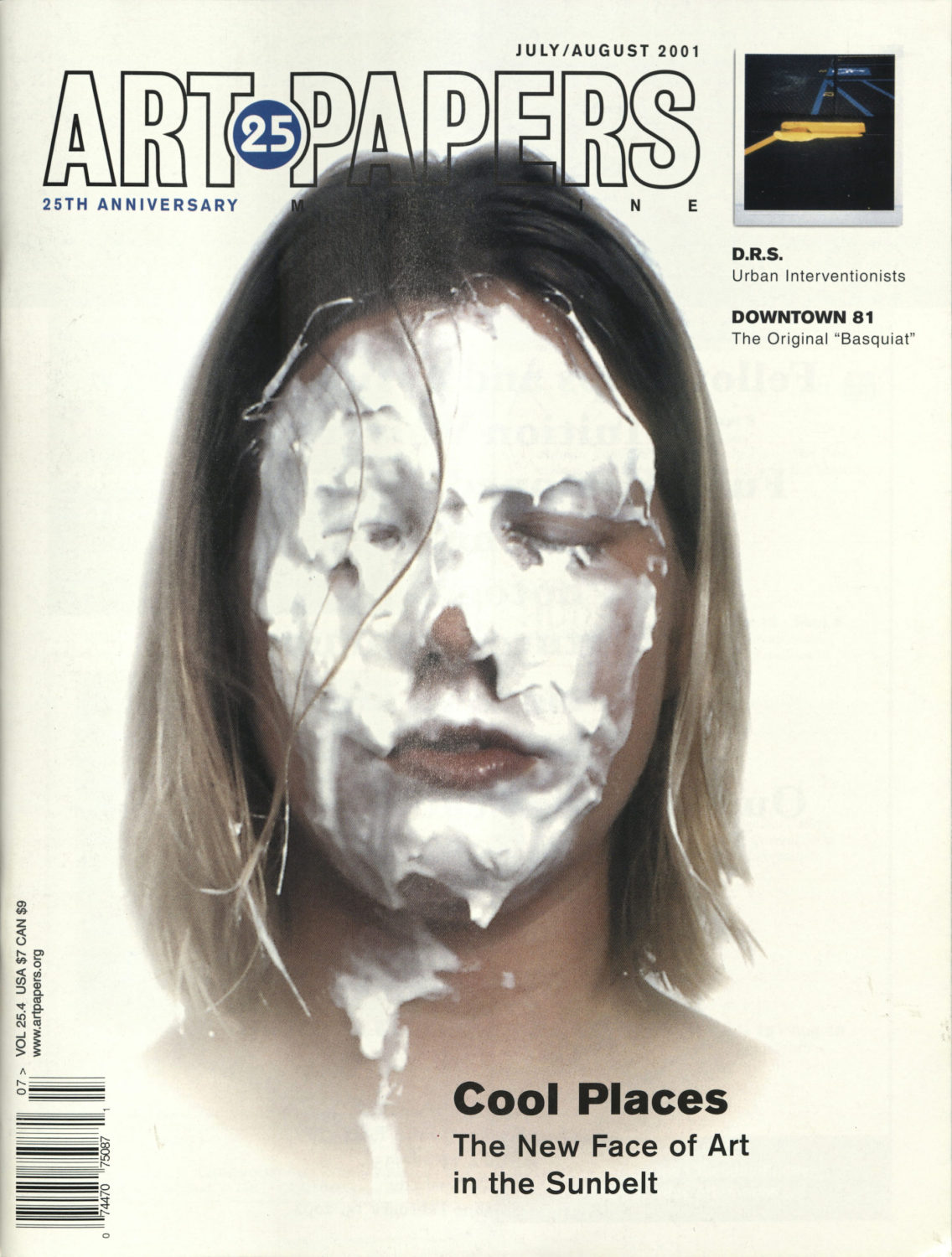
2001
The 25th Anniversary
This year’s anniversary volume addressed the magazine’s ongoing history through guest editorials from the former Editors, while contributions from past and recent authors explored current topics in art. These included Alan Sondheim’s account of 25 years as a web theorist and artist, Eric Bookhardt’s essay for the recent Readings column on portrait books of crowds, Sue Canning’s recounting of the careers of Martha Rosler and Barbara Kruger, and George Gessert’s study on art, nature and genetics. Gean Moreno and Carl Heyward made big statements through an issue on “Art, Sex and the Body,” while others such as Brandon LaBelle and William Kaizen broke new ground with articles on German sound artist Achim Wollscheid and the New York art-rock collective, Sonic Youth. Other articles covered the pragmatic philosophy of artist/architect and 1996 Olympic Cauldron designer Siah Armajani, globalism in conceptual art, and artists and contemporary domesticity. This year introduced a new column, “Performance Notes,” and also contained an interview with painter Jonathan Lasker. Volume 25 also saw the magazine’s first investigation in many years on the topic of regionalism through a major cover story on the growth of “Art in the Sunbelt,” which provided in-depth articles on the art scenes in Georgia, South Florida and Texas along with sidebars on 10 spots, from Charleston to San Diego, across the southern tier of the U.S.-a fitting tribute to the growth of the magazine and subsequent expansion of its original editorial mission.
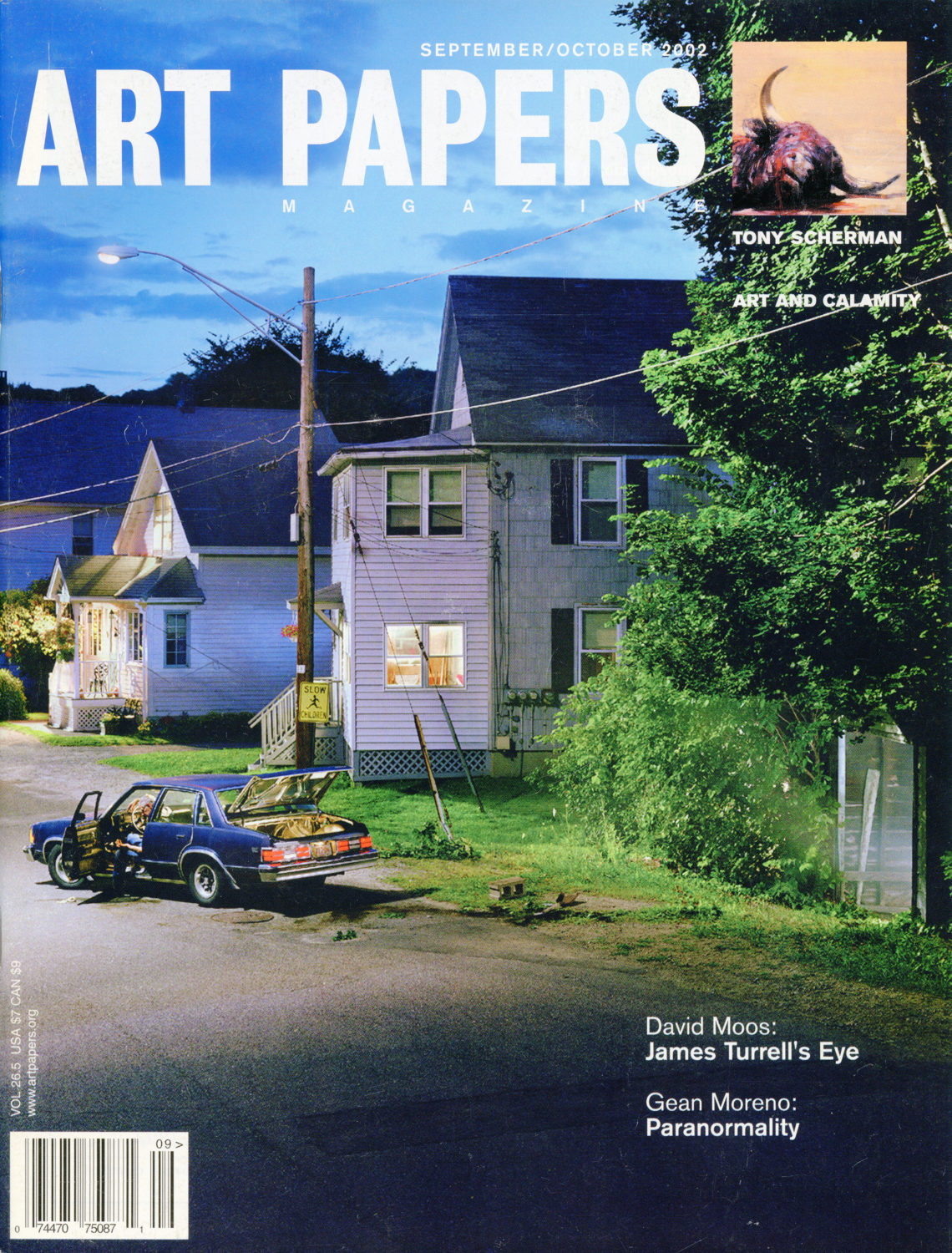
2002
A New Editor, and New Topics
2002 saw the arrival of the first Editor of Canadian nationality, Charles Reeve. The year began with an exploration of diverse topics that would recur later in various guises, from graphic novels to robotic performance in the Venice Biennale to the displacement of humanism and the rise of a new spirituality. The obituary of globally famed Georgia vernacular artist Howard Finster marked a symbolic point of transition, while a studio visit with Atlanta Afrofuturist Kevin Sipp marked another harbinger of things to come (long afterward). The following issue brought a conversation with curator Robert Hobbs regarding Kara Walker’s work at the São Paulo Biennale, L. Kristin Herndon’s perspective on the state of digital art, Gean Moreno on the meeting of contemporary art and car customizing, and Amy Landesberg and Leslie Fitzpatrick’s artists’ pages using and subverting cosmetics and false eyelashes. An essay on art in Mexico and a studio visit with Glexis Novoa rounded out the issue, continuing the custom of arranging studio visits relevant to major themes in the issue. Over the course of the year, essays contrasting the “shopping mall colonialism” of a New York survey show on Brazilian art with the nuanced perspective of a contemporaneous exhibition of artists from India and Pakistan, an interview with Okwui Enwezor on contemporary African art, and essays on white South African artist Kendall Geers, Brazilian conceptual artist Maria Tavares, and the vexed concept of “post-black” art demonstrated a set of overlapping concerns, alongside one-offs on Bruce Mau’s design philosophy, post-graffiti, the materiality of painting, apocalypse as a simplistic notion, and discontent in arts criticism in the American Midwest.
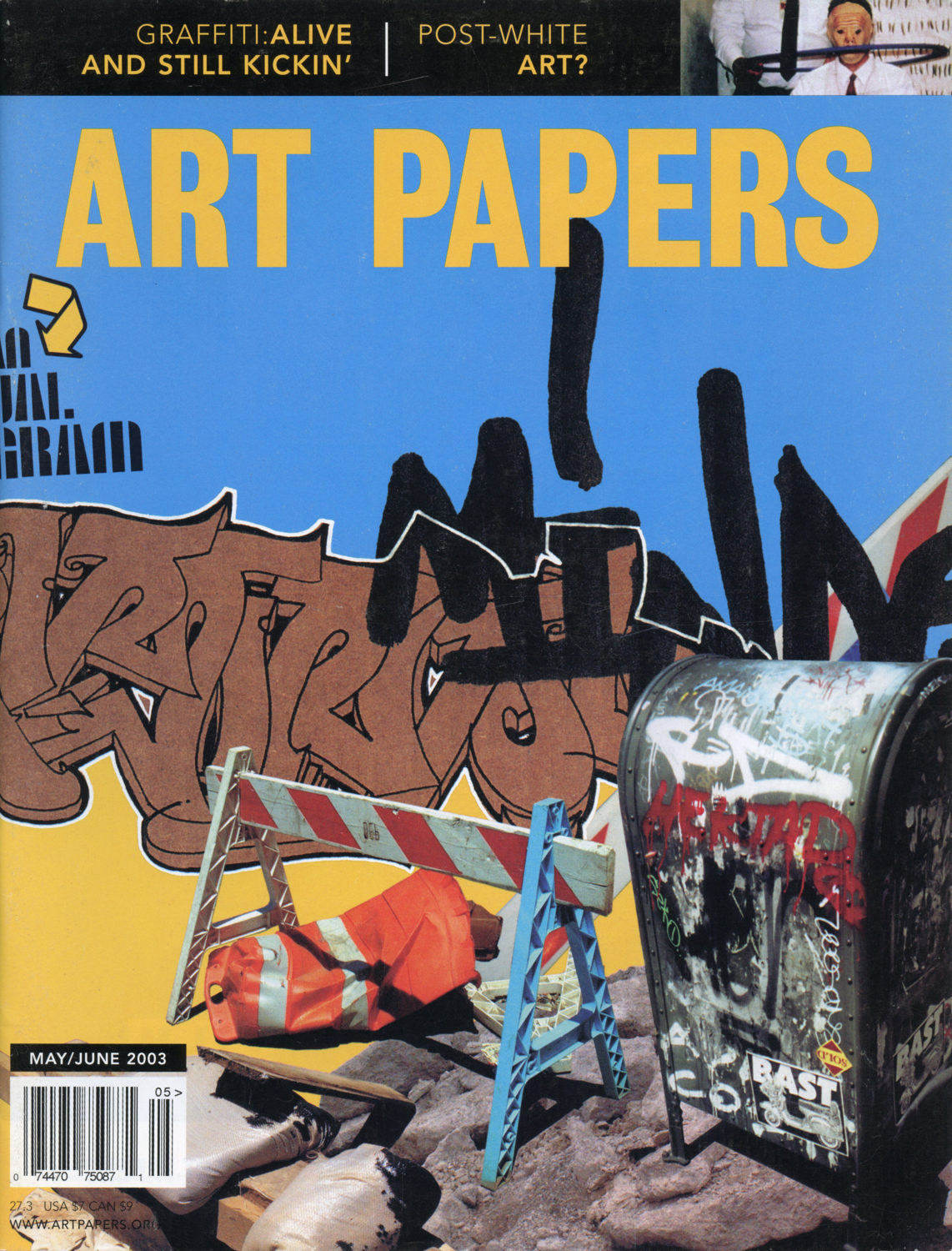
2003
An Ever Wider Range of Diverse Topics
Reeve’s editorship branched out in numerous directions in 2003, combining, for example, an interview with Fred Wilson, Gary Younge’s essay on the fourth plinth in Trafalgar Square, and an examination of Leslie Dill’s visionary poetics, or, in the succeeding issue, sustainable design, the problems of starchitect-designed museums, and grassroots environments by a new type of outsider artist. Essays in succeeding issues on the hybrid vigor of graffiti, an exposé of whiteness, and public art at Burning Man, and a defense of performance art by Guillermo Gómez-Peña revealed an ongoing interest in the complexities of margins, centers, and ethnic identities. A survey of Ruth Dusseault’s socially informed interest in and documentation of “the in-between zones of urban environments” and a feature story on the social activism of Alabama’s Rural Studio added architecture to the mix alongside essays on Fischerspooner as performance pop, abstract expressionist Manny Farber, Ingrid Calamé’s abstract paintings of floor stains in the centers of power, birth trauma for child and mother in the art of Matthew Barney and Mary Kelly respectively, and “Nude Orleans: From Bellocq to Bourbon Street” engaged an extraordinary range of issues. The photographs of Gregory Crewdson made a return engagement, this time in an essay pairing him with Raymond Pettibon, rather than the apocalyptic paranormality of Gean Moreno’s “The End of the Future” in 2002.
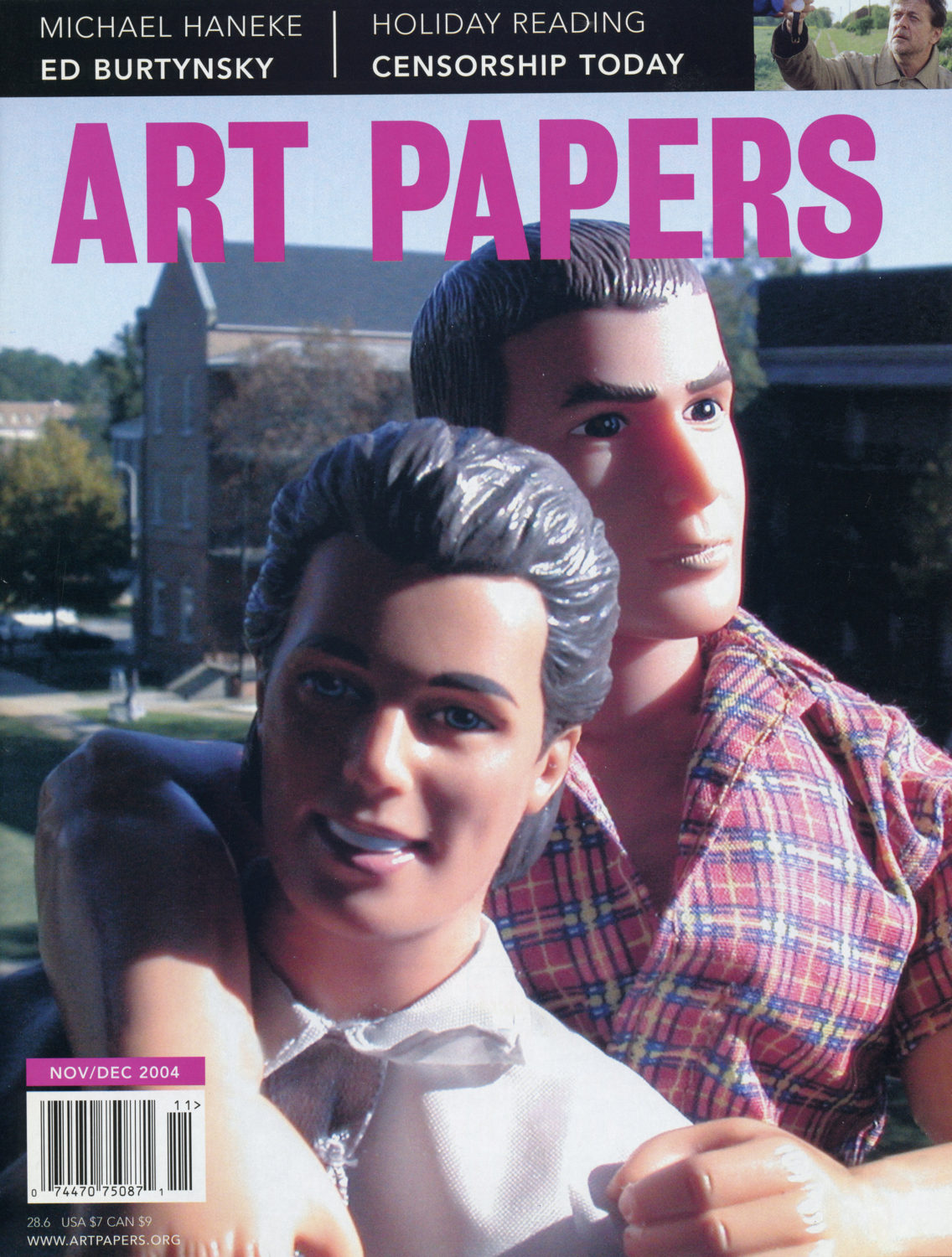
2004
Media, the World, and Regionality
Video art in California dealing with surveillance and Texas painters dealing with a post-paint world were thematically related topics with which the year began. The succeeding issue saw Dallas artists occupying a slippery slope between painting and photography in “A Painting of a Picture of a Photocopy.” In the same issue, “Representing Blackness” explored Kerry James Marshall’s meditations on the black aesthetic, while Michael Friedländer explored the aesthetic and social themes of Soviet and post-Soviet art. Japan’s interest in hip-hop was explored by iona rozeal brown in a studio visit, and, improbably, a new documentary analyzed by Art Papers editor Charles Reeve presented the ongoing enthusiasm for Andy Warhol in his ancestral village in Slovakia. Jerry Cullum wrote an accompanying essay on the elusive ethnic identity of the Ruthenian borderlands and Andrew Warhola/Andy Warhol himself, and expanded on this general theme in a succeeding issue in “Between Berlin and Benin: Hans Haacke and Meschac Gaba, Two Political Artists in the Age of Globalization,” a theme echoed in a different register in Dennis Raverty’s essay on Siah Armajani and in a conversation with Adrian Piper. Gender politics put in an appearance in Richard Meyer’s “After the Culture Wars: Censorship’s Many Faces,” and environmental activism in John Grande’s essay on the photographs of Edward Burtynsky.
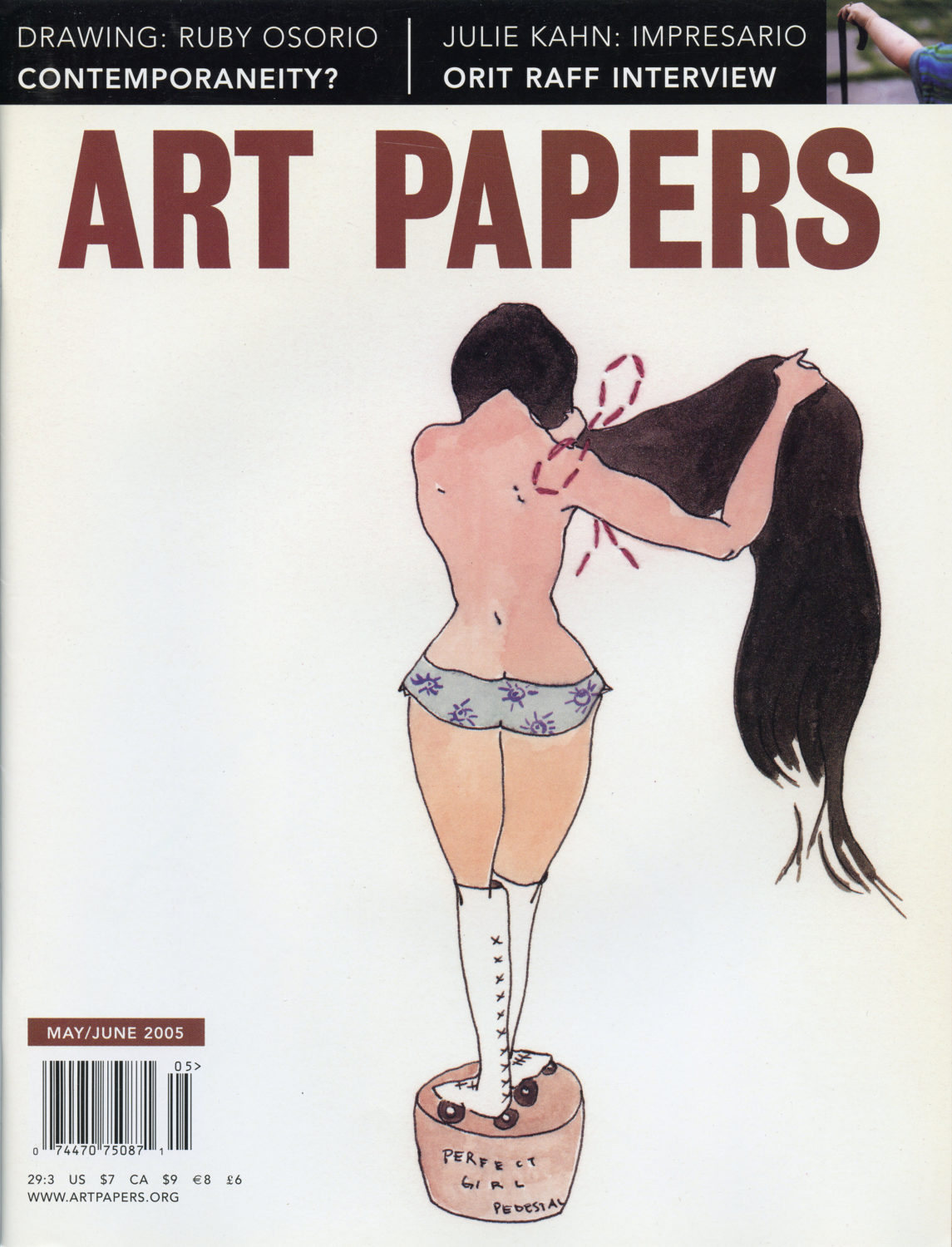
2005
The Second Editor from Canada
Or, more specifically, from Québec. Sylvie Fortin arrived with a different perspective on international art and the place of an Atlanta-based magazine in it. The first issue under her exclusive editorial control featured a spectacular range of issues of political and gender identity from “Fatimah Tuggar’s Imag(in)ing of Contemporary Africa” through Tania Bruguera’s Cuba-themed intervention at Art Basel Miami Beach to the very different architectural perspectives of Arakawa and Gins in one feature story and Swedish artist Charlotte Gyllenhammer in a studio visit, perhaps linked to the notion of the “spaces between” in the studio visit with Athens, Georgia artist Ron Johnson. The next issue’s studio visits with Lorenzo de los Angeles in Queens, New York, Millie Chen in Ridgeway, Ontario, and Giuseppe Gabellone in Milan demonstrated the expansion of the magazine’s longstanding interest in art as a global practice, a focus reinforced by a feature essay on the economic of marketing contemporary Australian Aboriginal art. The year’s remaining issues presented conversations about larger artworld themes, including “Civil Disobedience as Art, Art as Civil Disobedience” and a two-part discussion of “Curating Now.” A studio visit with globally recognized Atlanta book artist Ruth Laxson served as a reminder that the city from which the magazine originated was by no means absent from the international artistic dialogue.
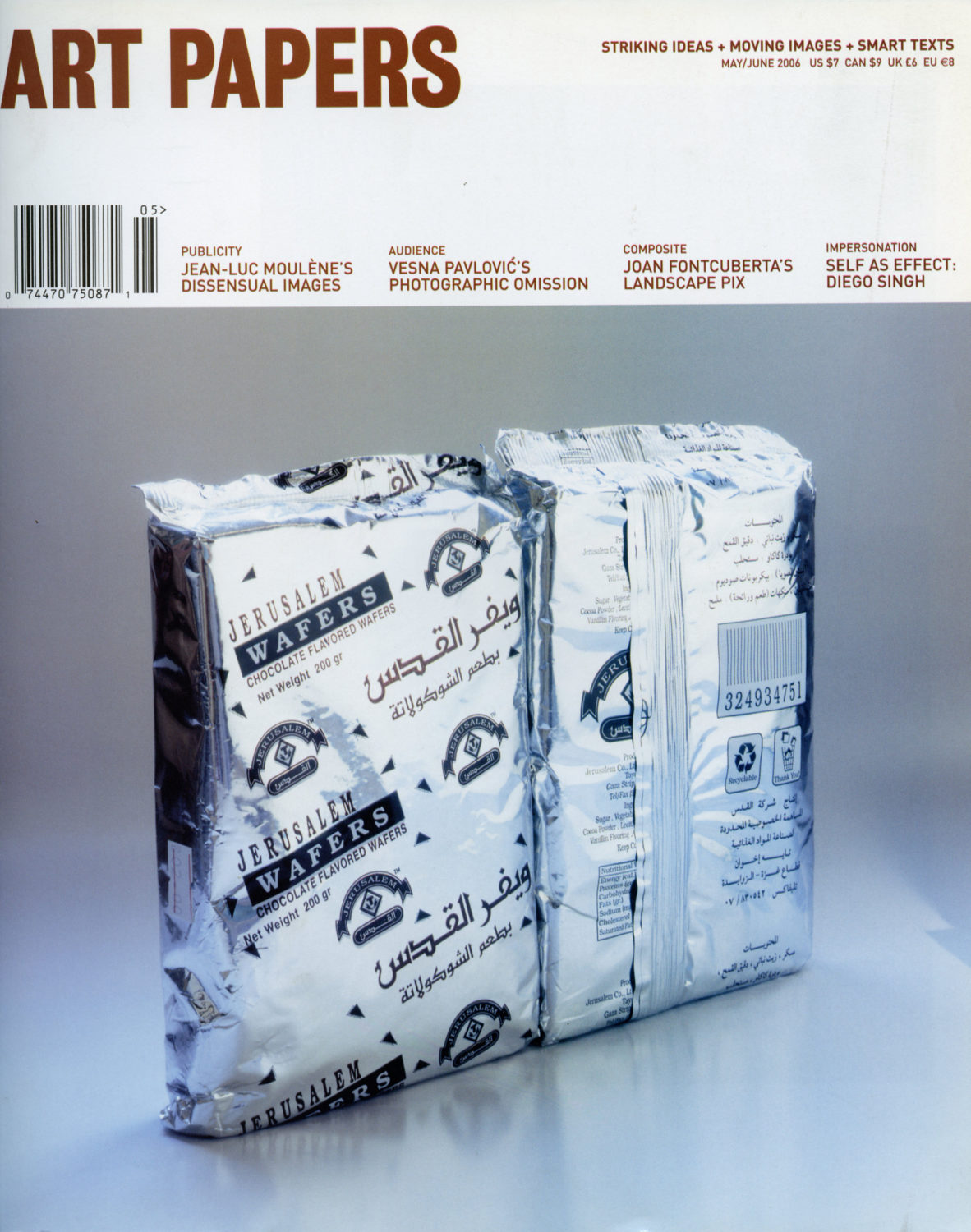
2006
A New Format for a Continuing Editorial Philosophy
The “studio visit” label for conversations with global artists was gone along with other familiar visual cues, replaced by a new strikingly contemporary format suited to the magazine’s new subheading “Striking Ideas + Moving Images + Smart Texts.” The first issue in the new format began with a report on a Chicago conference on art criticism and ended with “Istanbul Biennial 2005: Art and Politics on the Edge of Europe,” continuing the magazine’s historic focus on alternate centers of art production with an on-location visit with Eve Sussman during the making in Greece of her new video-opera. Subsequent issues revisited Istanbul for a look at art collectives, while global biennials returned in a David Moos-Magda Gonzalez-Mora dialogue about the Bienal de la Habana. “Art as a Strategic Weapon in Israel’s Culture Wars” counterpointed an essay on Jean-Luc Moulène’s photographs of Palestinian commercial products. Longtime correspondent D. Eric Bookhardt described the resurgence of New Orleans art after Hurricane Katrina, while a two-part report on an ambitious conference at in Austin was an illustration of the Blanton Museum’s determination to situate contemporary Latin American art in a global art historical context. In the year’s final issue, an essay on Vaginal Davis’ “terrorist drag” set an appropriately confrontational tone, somewhat moderated by essays on Hilary Wilder’s reformulations of landscape painting, Pierre Huyghe’s screen-based exhibition in London, and a studio visit (but not headlined as such) with Cairo artist Hassan Khan.
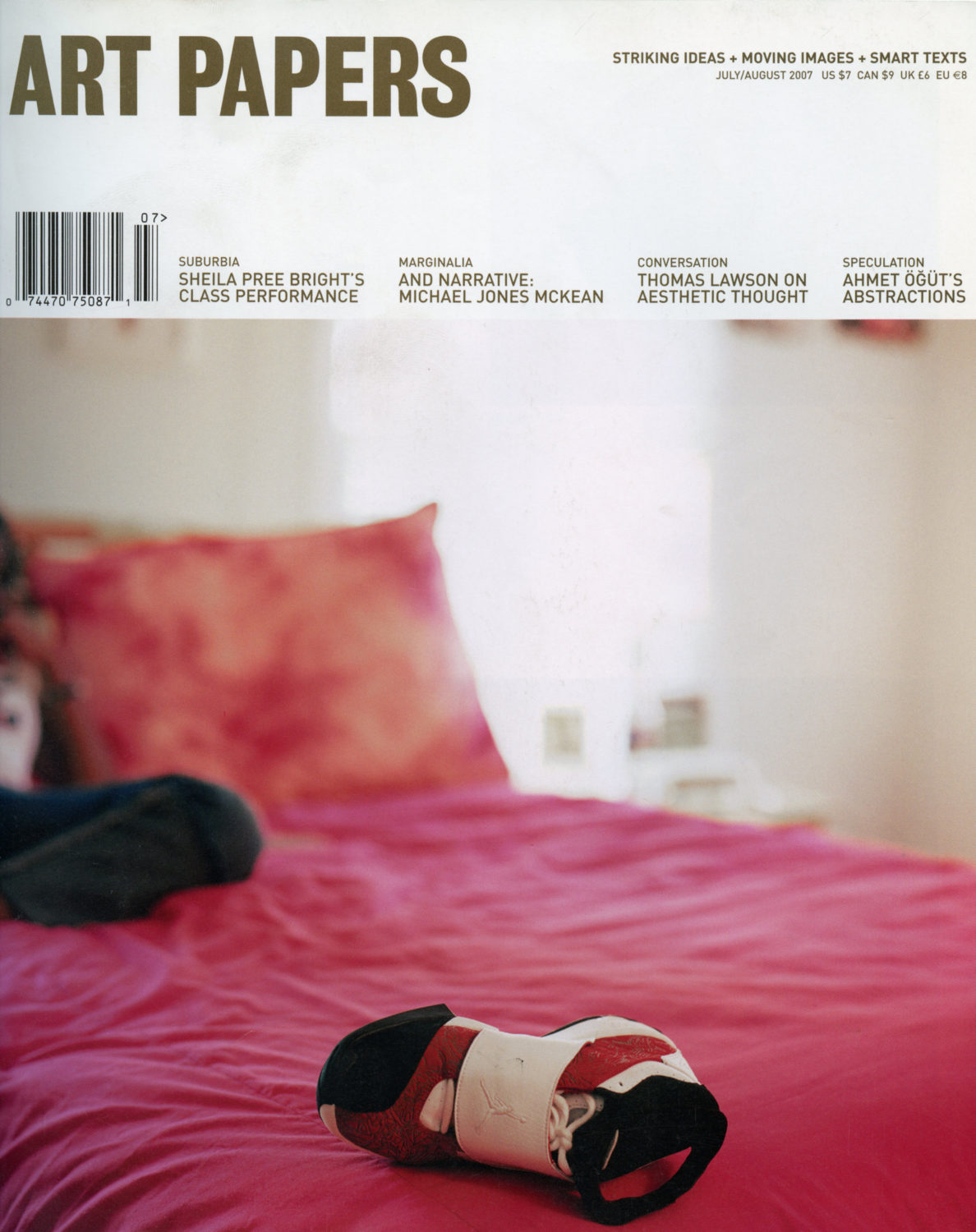
2007
Pirates, Ninjas, Black Metal, and Tate Modern
The eclectic definition of the contemporary conceptual became apparent as 2007 unfolded. Recent paintings by Zhang Xiaotao were written about adjacent to an interview with the director of Tate Modern and Glenn Kaino’s reflections on ninjas and pirates, revolution and romanticism. By year’s end the aesthetics of ambient audioscapes co-existed with the graphic design of logos for black metal bands. The activist art of the Center for Tactical Magic appeared alongside the more diffuse gender politics of Mathilde ter Heijne, the politics of Sheila Pree Bright’s photographs from African-American suburban homes (another Atlanta artist highlighted), and longtime theorist Thomas Lawson on history, tactile/visual thinking, and the politics of painting. “Curating Environmentalism for Post-Industrial America” rhymed oddly with a meditation on art’s recent fascination with shadows as evocations of non-place. Artists from San Francisco to Istanbul by way of Western Europe presented a spectacular set of diverse options for thought and artmaking, with interests ranging from “pictorial justice” to the place of historical memory in a post-1989 global condition. Past concerns with paradoxical architecture surfaced in an essay on the installations of Michael Jones McKean. In general, the broad range of interests evinced by the artists under discussion made tidy summation difficult, a situation that would continue over the next three and a half years.
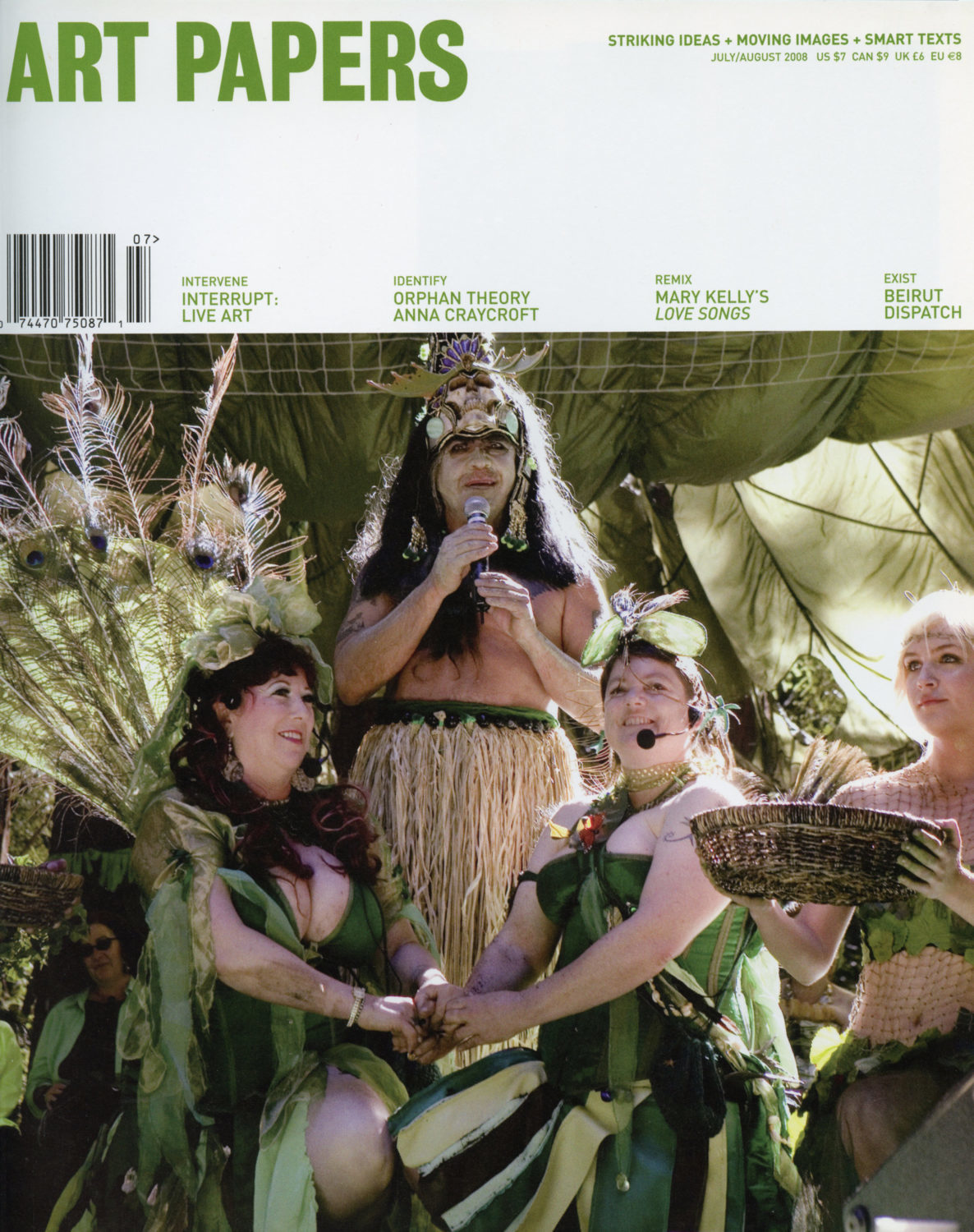
2008
Global and Local Questions Continue to Surface
The year began with reports on biennials in Istanbul and Mercosur and ended with stories about environmental interventions by Olafur Eliasson poised between sculpture and critique, Yael Bartana on a Palestinian house built by the Israeli Committee Against House Demolitions, vegetable gardens as activist interventions by Fritz Haeg’s Edible Estates and various collectives, and Alabama artist Walton Creel’s creation of detailed drawings with bullet holes in his “Deweaponizing the Gun” series. This might suggest that although ongoing interests in activist interventions and conceptual experiments might be a unifying theme, little else would be amenable to tidy summation. Gender politics also appeared in K8 Hardy’s conversation regarding eclectic second-wave-feminist performance and in an essay on Mary Kelly’s “Love Songs” series, and less specifically in too many articles to enumerate. Christodoulos Panayiotou presented documentation of the hitherto unsuspected peculiarities of Carnival in Limassol, Cyprus. Ernesto Oroza discussed his intent in using found objects to create sculptural commentaries on the improvisational economy of day-to-day life in Havana. Jamie Isenstein discussed her sculptures completed only by becoming a hybrid with performance via the insertion of the artist’s body. (Katharina Grosse acknowledged in an interview in the same issue that her own work is “a notation for the absence of [her] body,” the presentation of the two opposing practices suggesting a subtle concern with embodiment unacknowledged in the editor’s preface to the issue.) An essay on Victor Man discussed the phenomenon of his emergence from the unlikely starting point of Cluj, Romania.
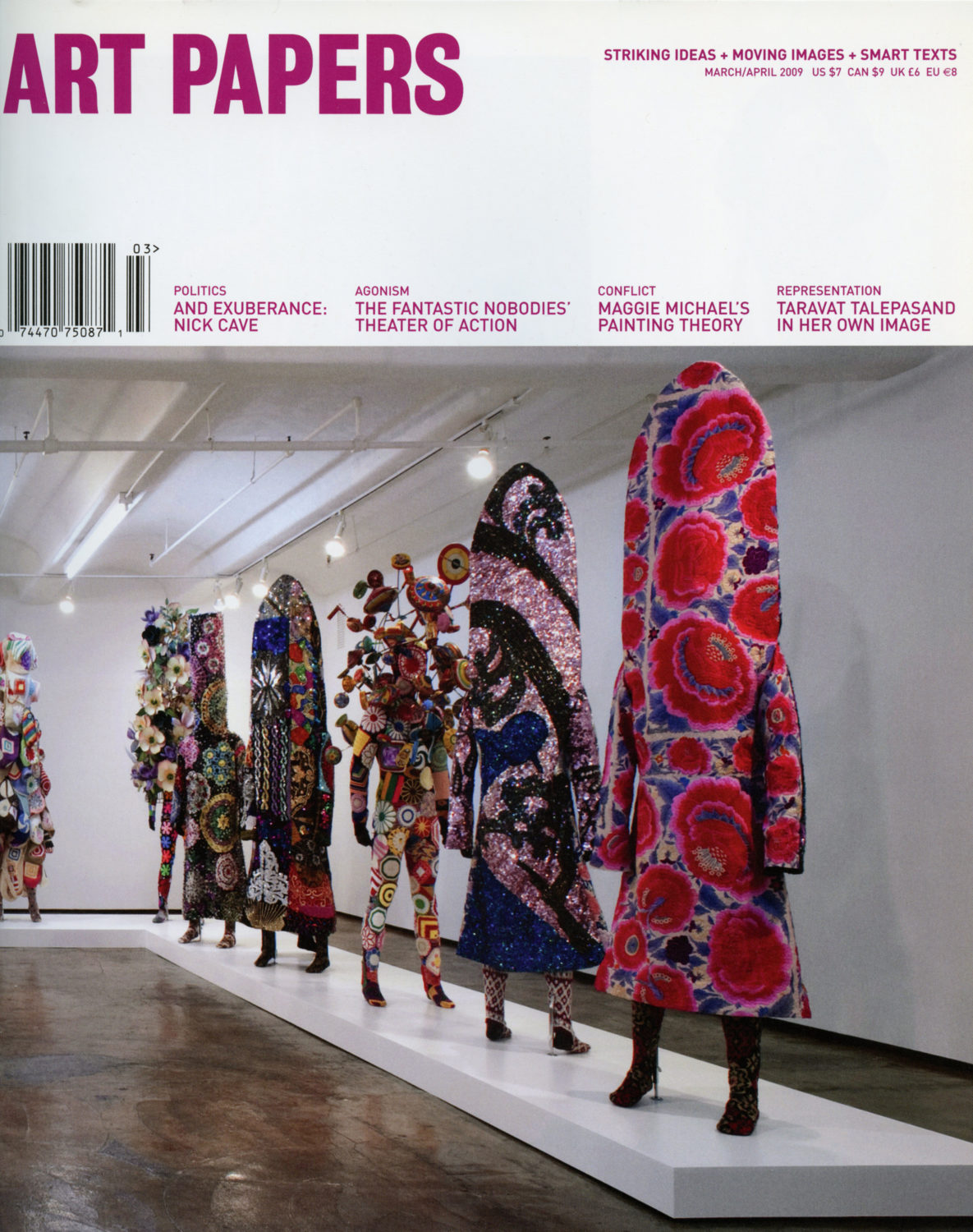
2009
Semiotics of the Hidden Empires, or, “Like Greece, I Tell You”
The year began with expositions of Mel Chin’s artistic explorations in monetary exchange, Maryan Jafri’s subversions of the truth of historical documents and of documentary film, Jason Varone’s video paintings of the hyperreal, and Michael Tedja’s “strategic use of excess to disrupt institutional codification.” The next issue established a loose theme of alternative theatricality, juxtaposing an essay on Nick Cave’s sculptural soundsuits and a discussion of the Fantastic Nobodies’ resurrection of Dada and Fluxus aesthetics in performances in Brooklyn and Berlin. Taravat Talepasand’s feminist updatings of Persian miniatures rounded out the issue. The subversion of institutional assumptions would be assessed in the following issue in terms of Iris Häussler’s fictional archaeology and Joep van Liefland’s conceptual video store, and the exhibition design of Musée du Quai Branly’s “The Jazz Century.” Subsequent issues touched on the topic of activist art, begun with a discussion of Jeremy Deller’s road trip to provoke discussions about Iraq and continued with “Trevor Paglen: Semiotics of the Hidden Empire,” about Paglen’s documentation of concealed military and intelligence sites. The same issue introduced a series of essays on and interviews with artists in a Greece that was becoming a byword for social and financial difficulty. An essay on the Claire Fontaine collective in France, like the one in the preceding issue on Kansas-based activist collective spurse, focused on the fresh prominence of anti-individualist group production of socially based artwork.
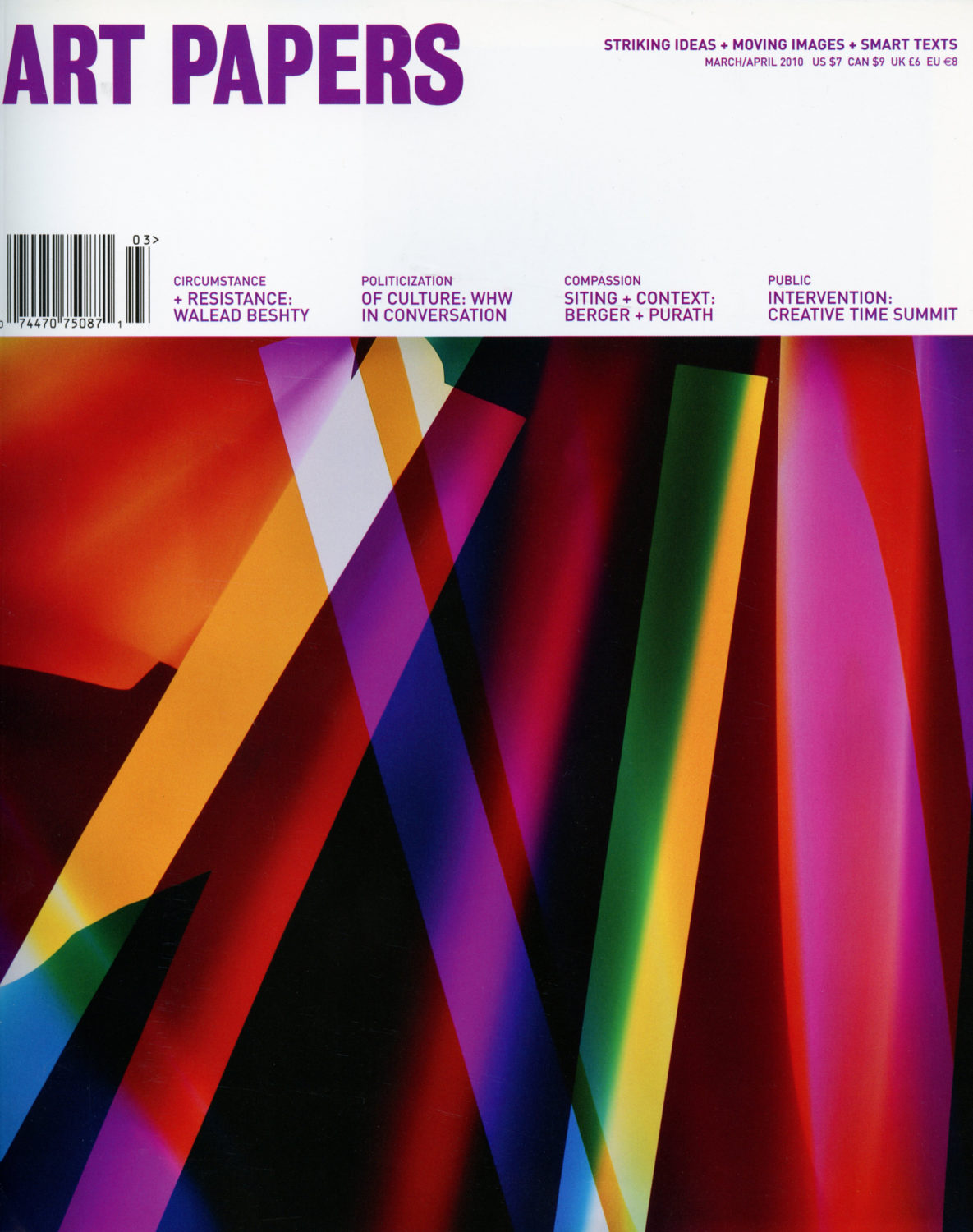
2010
Collaboration, Critique, and the Creative Time Summit
Another eclectic but focused year began with Rebecca Dimling Cochran’s analysis of the North Carolina collaborative organization and artist residency program Elsewhere. Other articles dealt with Hadassah Emmerich’s postcolonial feminine exoticism, Stelios Faitakis’s recuperation of religious icons, Julika Rudelius’ video explorations of desire and prejudice, and the disturbing realist-object drawings of Manny Prieres, thus taking the reader from Greensboro and Miami to Berlin and Athens, with side trips to spaces with less geographic specificity. In the subsequent issue, Maria Antelman’s space cowgirldom in Athens continued a multi-issue focus on artists in Greece placed in a global context, while Alabama artists Berger + Purath produced billboards of universal compassion in Atlanta, Memphis, and New Orleans, the curatorial collective WHW pondered the aftermath of their Istanbul Biennial, Walead Beshty proposed new architectural interventions, and the Creative Time Summit tried to make sense of the various forms of public practice. The rest of the year ranged from an interview with Brian Holmes regarding his theoretical approaches to such topics as how “the capitalist imaginary has overcome democratic institutions and reshaped contemporary subjectivity” while art can help produce “some kind of break in our current understandings of what life in society is good for.” Such a break might be implicit in subsequent interviews with Renzo Martens on how documentaries romanticize suffering, Noah Simblist’s essay on how the fetish of (anti-)Nazism domesticates evil, and Zoe Beloff’s artworks purportedly documenting an imaginary working-class psychoanalytic club in the Coney Island of the 1920s, or in Matts Leiderstam’s attempt to insert into Dutch art history his subjectivity as a gay male artist, or in Anthony E. Elms’ critique of Chicago’s failure to comprehend Liam Gillick’s concept-laden art.
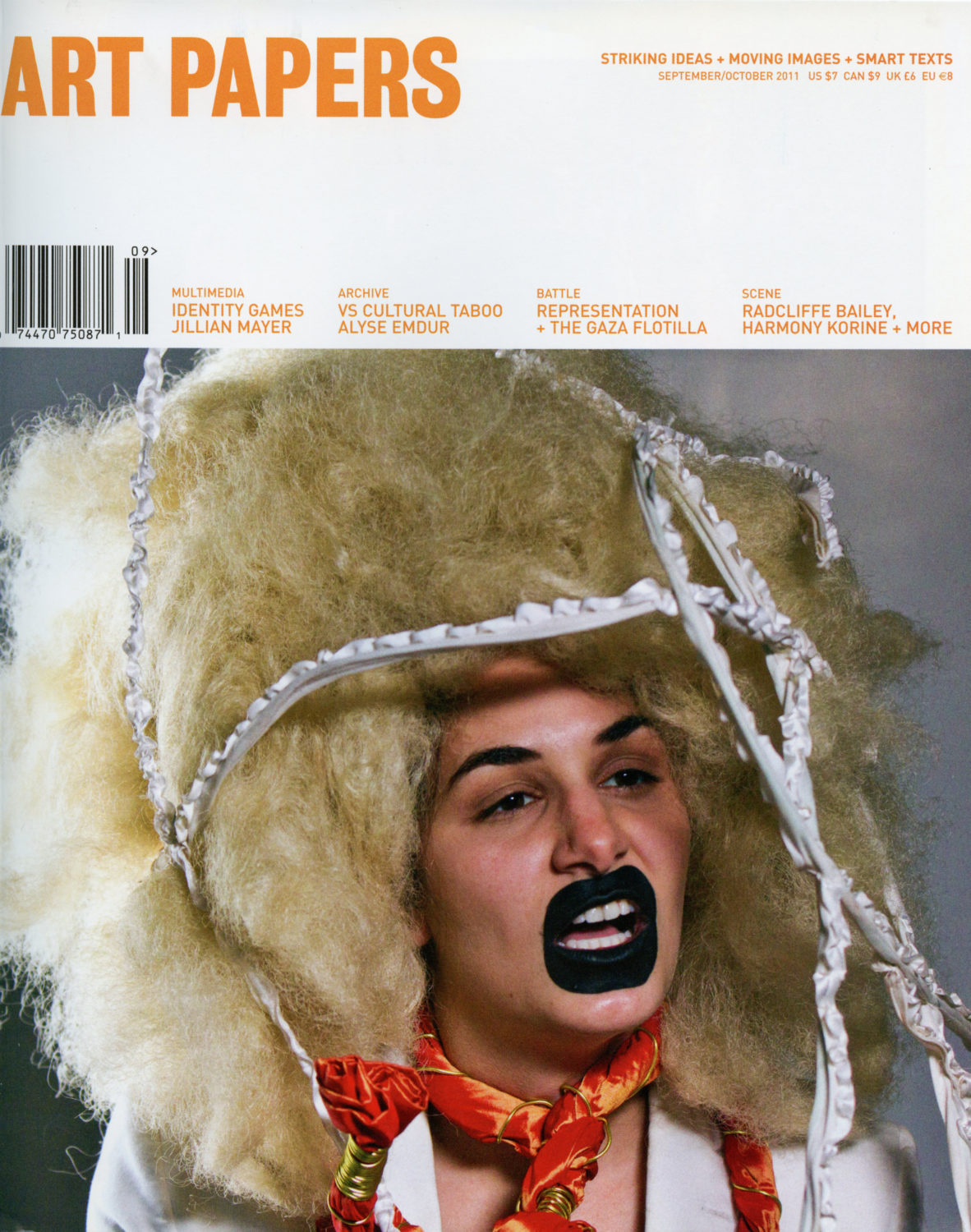
2011
Collectives and Continued Global Confrontations
IngridMwangiRobertHutter’s fused performance identities rhymed strangely with Jillian Mayer’s comic games of identity, and the successive iterations of the Gaza Freedom Flotilla were seen as “heterotopia on the high seas,” while Michael Hardt pondered the collective distributed intelligence of the post-individual common. The awkward nature of finding a language in which to discuss collectivity was a repeated theme of the year, beginning with The People’s Biennial and continuing with a report from Berlin’s First Congress of the NSK State, the globally distributed “state in time rather than space” founded by a Slovenian artists’ collective. The uncertain geographies of Alec Soth’s photographs in the Appalachian hideout of a homegrown terrorist and Christy Gast’s around Lake Okeechobee made clear that the flows and displacements expressed in Ireland by the art of Dennis McNulty and across the planet by NSK extended into rural corners of the American South. Carlos Sandoval de Leon’s concealment of startling subject matter within innocuous stacks of books or other objects viewable only through Plexiglas explored the conceptual and historical spaces inhabited by the immigrant artist. José Lerma’s academicized monumental cartooning and Anthony Huberman’s ongoing project The Artist’s Institute demonstrated the firm placement of such ideas within the realms of art institutions. When the previously mentioned interviews and essays are considered in conjunction with articles on such impossible projects as Douglas Huebler’s announced intent to photograph Everyone Alive, the year’s half-dozen issues almost demand to be understood in retrospect as a collectivity, delivering a cumulative impact greater than the individual parts.
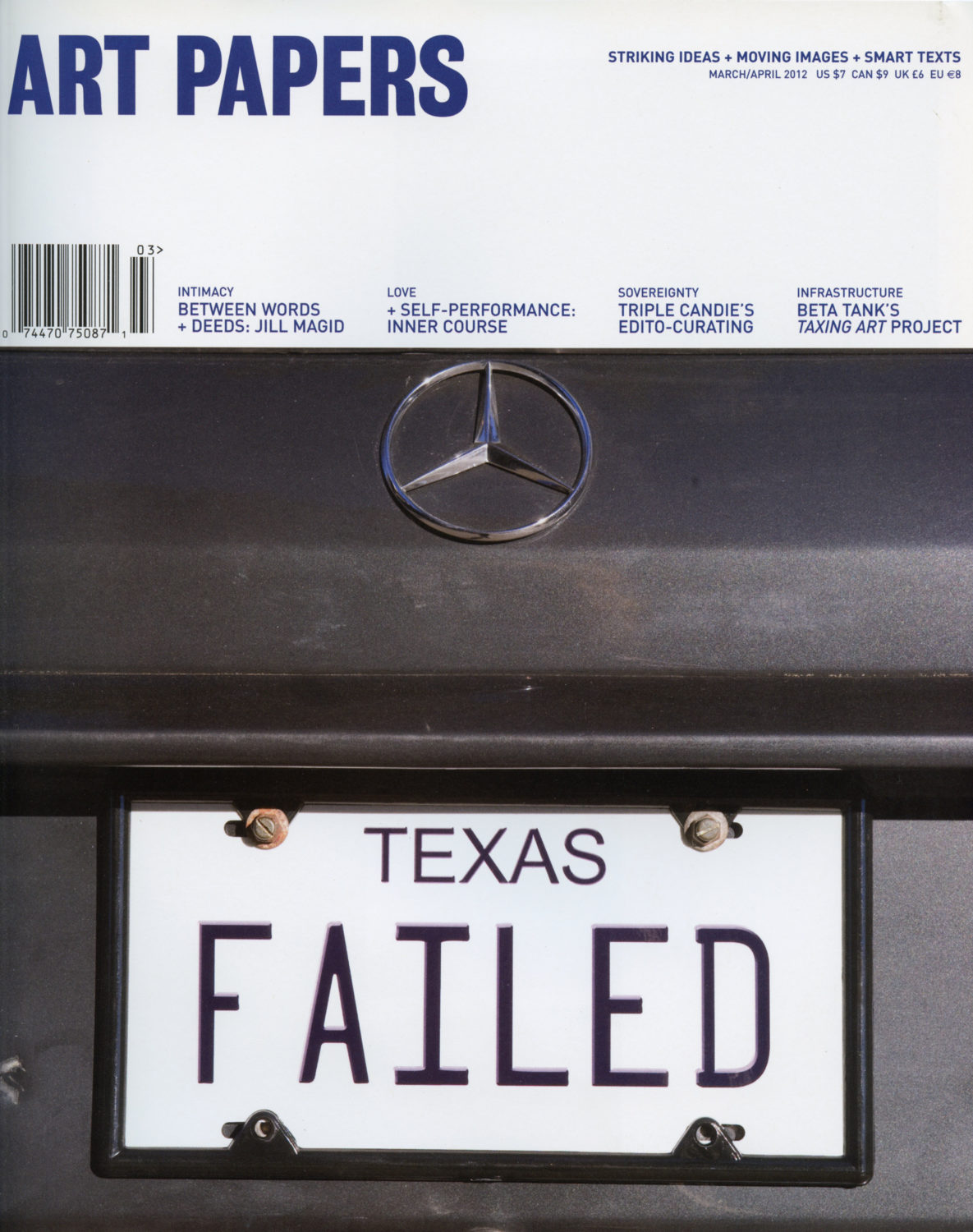
2012
An Editor Departs, and Various Others Take Over
2012 began with echoes of earlier themes, as Larissa Sansour reframed old issues with the fantasy of “The Possibility of a Palestinian Space Program,” Andrew Bucksbarg explored sociality through audience use of an iPod, and David Zink Yi brought his own ethnic and cultural hybridity to the hybrid religious and musical practices of Cuba. Beta Tank explored the world of networks in which art now found itself taxed when objects travel, and Jill Magid looked at the aftermath of a victimless shooting into the sky in Austin, Texas. Gender, power, and public relations made repeat appearances in the cultural production surrounding the Occupy movement, the Bloomberg administration’s support of museum displays highlighting its social initiatives, and a film project by Milford Thomas deeply embedded in the history of Atlanta subcultures. And then Cinqué Hicks’ two-issue stint as interim Editor carried forward these dominant concerns in a slightly modified register. A survey of collectives in a financially challenged Athens, Greece complemented Sven Augustinjen’s video exploring the troubled colonial legacy of the Democratic Republic of Congo. An interview with Performa 11 curator Mark Beasley and an essay on the gender politics of Rita Ackermann’s paintings carried forward now-familiar interests. Under the new leadership of Executive Director Saskia Benjamin, the magazine began an eight-issue guest-edited series starting with Sarah Workneh’s issue on Art in the African Diaspora. The year ended with an extraordinary look at topics including the grotesque as female artists’ strategy in Afrofuturism, Paul Miller’s multimedia evocation of an environmentally threatened Antarctica, transnational practice in Caribbean art, The Association for the Advancement of Creative Cinematic Maladjustment, and the legacy of Nina Simone.
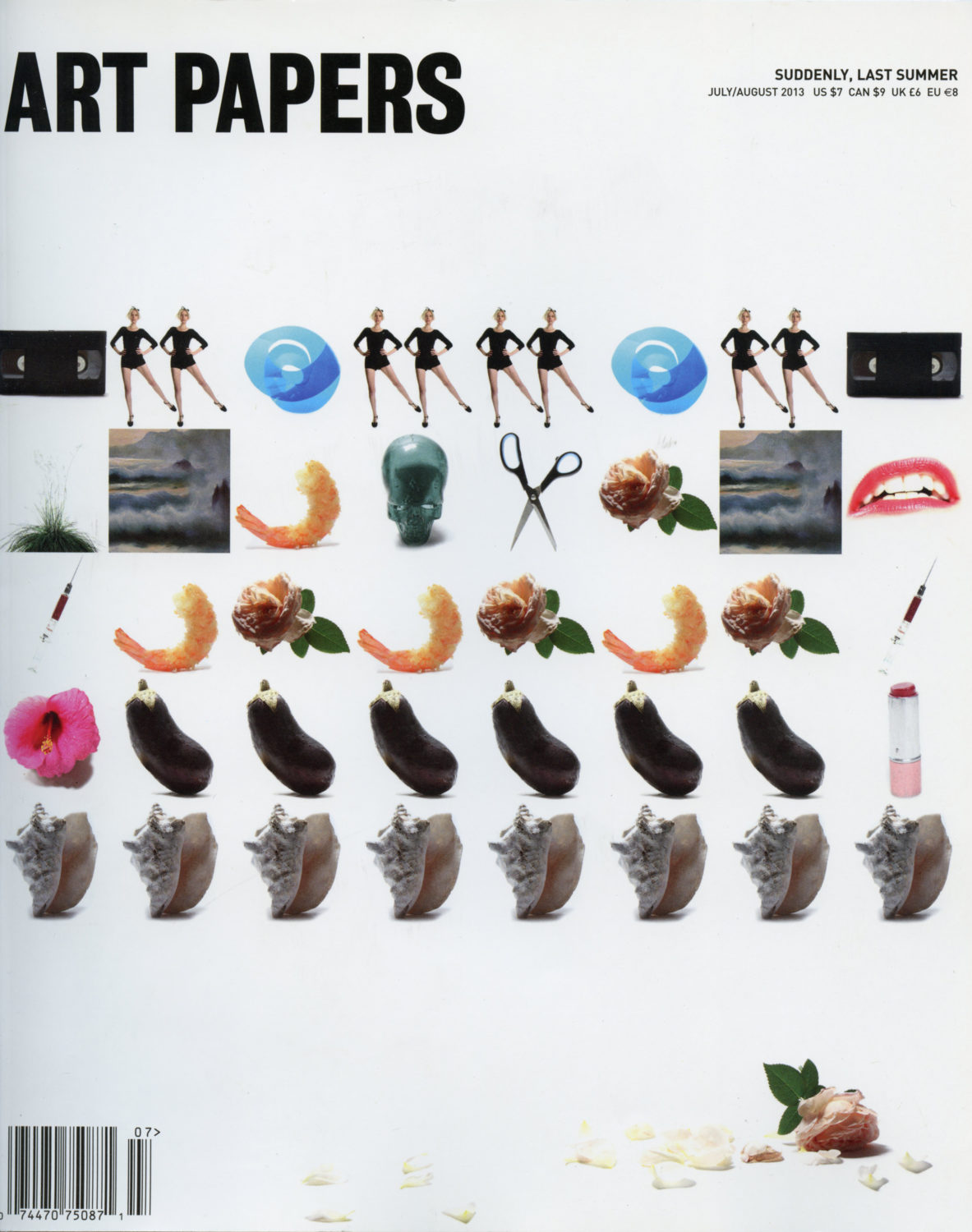
2013
The Year of the Guest Editors
Niels Van Tomme’s issue “On Temporality” led off the year with topics ranging from Christian Marclay’s 24-hour The Clock to notions of time in Gambia, with stops along the way in São Paulo, Paris, New Delhi, and sites in Thailand, Croatia, and Lebanon, alongside artist-run spaces adrift in historicity in New Orleans. Susan Morgan devoted the next issue to design and the built environment, with John Latham’s temporally inflected “Flat Time House” providing a link to the preceding topic. The issue began with a reconsideration of the 1939 Telesis group in California, continued through Swedish designer Greta Magnusson Grossman’s 40-year career, and concluded, chronologically, with transformational proposals for the Sugar Hill Arts District in Detroit and the East River Blueway in Manhattan. Erin Dziedzic’s subsequent issue explored “identity, location, exile, [and] the fleeting nature of space and time” from Mike Kelley’s mobile homestead to the shifting meanings of “regionalism,” the complex geographies of Shirin Neshat, and the “fairennial” model as art fairs grow in importance and proliferating global biennials become ever more problematic. The next issue, edited by the MALONE design and art collaborative of Alex P. White and Strauss Bourque-LaFrance, featured a hiply ironic coded cover by North Georgia artist Jody Fausett and essays dealing with painting in the information age, art after social media, delinquent bodies, and sisters Amy and Wendy Yao “skyping with coffee and cats.” After this, September/October’s “The Theatrical Turn?” with editors William Corwin and Alex Ross might have seemed almost old-school in its attention to real bodies and live performance, except that “Body Sketches for a Universal Stage” and “Demonstrative Urgency of Performance in the State of Resistance” made it clear that theater, public performance, and video mesh in ways that address our most immediate social issues, even as Sarah Lucas and Gelitin demonstrated in conversation that “No One Is Less Dead Than Franz” [West] and the aftermath of Viennese Actionism. Dushko Petrovich delved even deeper into traditional media with an end-of-year issue devoted to the topic of art magazines of all sorts.
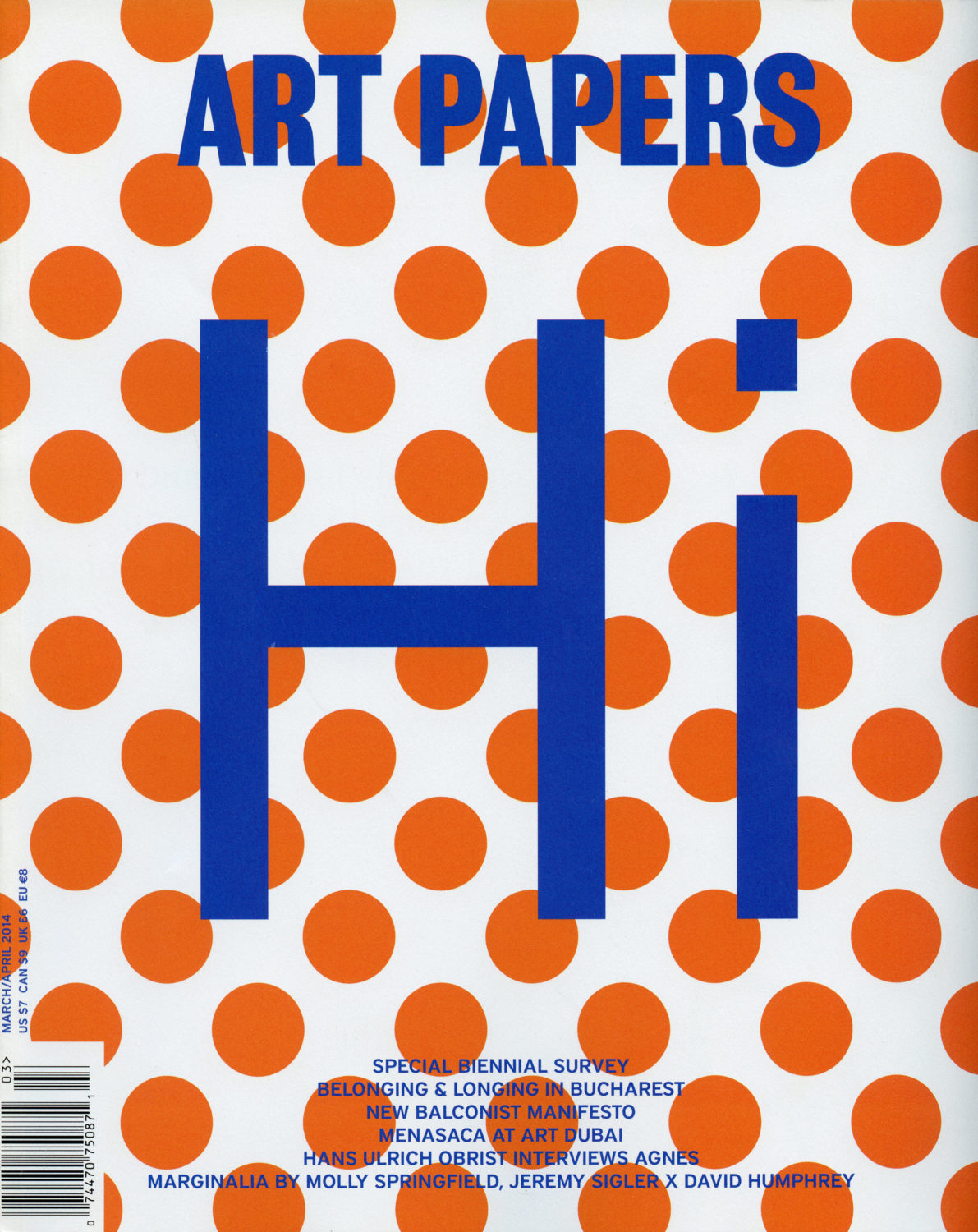
2014
A U.S.-Born Editor Arrives via London and Berlin
Guest editor Fahamu Pecou led off the year with a spectacular study of Art x Hip-Hop, begun appropriately with an invocation of trickster Eshu and the diasporic tales of Basquiat and Kendrick Lamar and flowing onward through the burgeoning of queer hip-hop, a new-millennial black dandyism, and neo-hip-hop cultural expression. After that, Victoria Camblin brought her fresh editorial sensibility to the magazine, exploring the Bucharest Biennial that never was, the Slavs and Tatars collective’s invitation to Central Asian art spaces to exhibit at Art Dubai, experimental arts education in West Africa, a proposal for art reflective of a people’s culture independent of state structures, and, among other things…Hans Ulrich Obrist interviewing an emotionally perceptive spam bot, Douglas Coupland defining “occession,” the use of smart-phone apps to renew public protest—the usual, plus surprises. Bruce Mau made a return via a commencement address, new British ceramics nestled next to discussions of the data self, flow charts of process cohabited with different ways of looking at the Whitney Biennial, and the visual transgressions of Chicago Imagism got a fresh examination alongside an interview with Jay Kinney about how his influential Gnosis magazine coupled occultism and technology with the spirit of American underground comix. If all this weren’t enough, the regional imperative reappeared in Franklin Sirmans’ combination of global and local in New Orleans’ Prospect 3, and internationally famous Atlanta-based musician and vernacular artist Lonnie Holley shared a page spread with a memorial homage to a beloved Atlanta chef and “matriarch of sorts.”
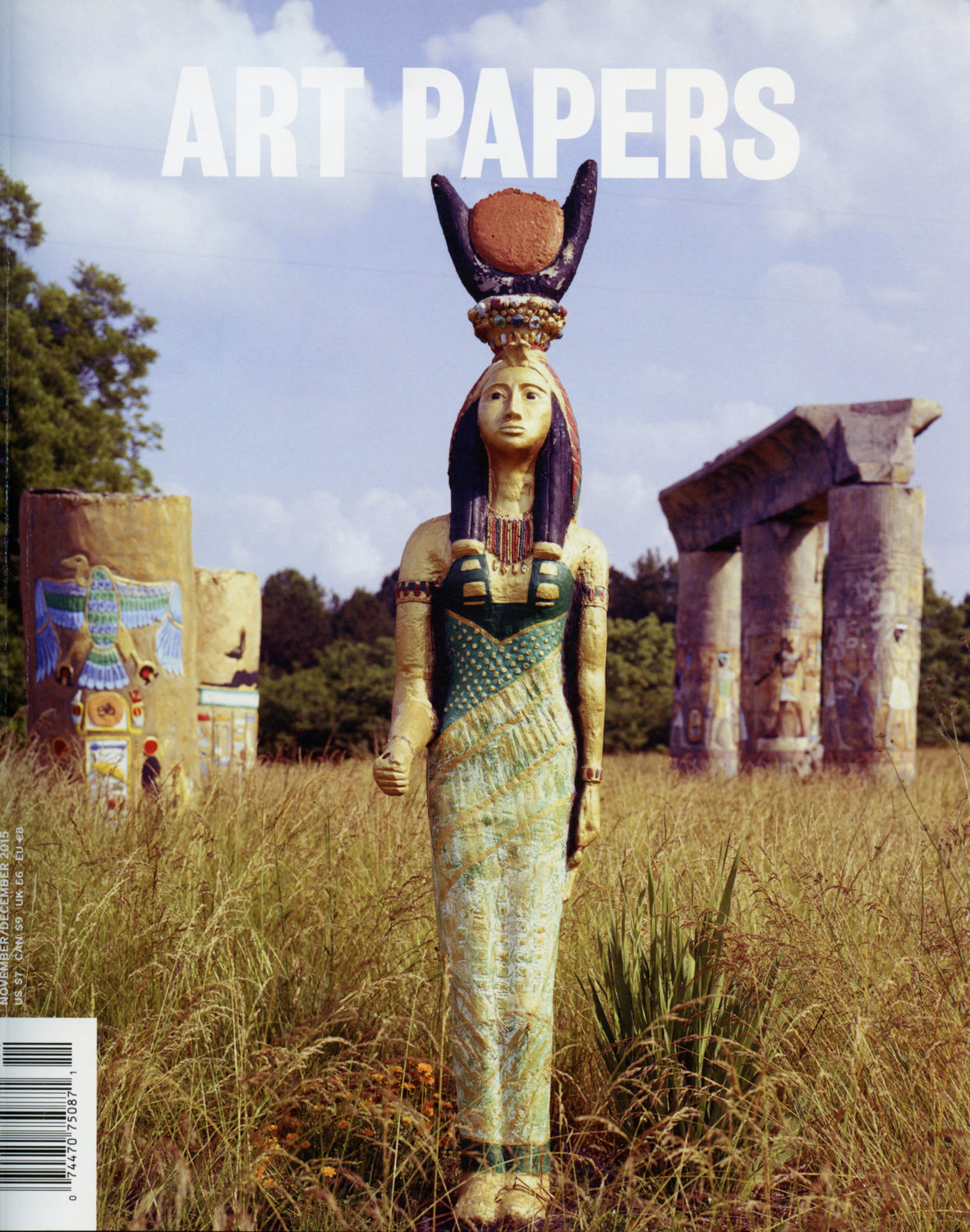
2015
The Stubbornness of Space, the Forms of Fashion . . . And So On
“It’s Only the Beginning,” as Daniel Fuller wrote of the resurrection of the lost archives of Atlanta’s Nexus Press in an era in which the archive has not lost its fascination. But Robert Wiesenberger’s special issue on Architecture and Design took a different look at Art Papers’ favorite topics, as Shumon Basar discussed how the study of architecture made him “more neurologically wired to see the interconnectedness of things [and] predisposed to ignore the sovereignty of disciplines” before he lost interest. After that, subsequent issues’ interest in the political aesthetics of Carnival, informality and nomadism, “A Pilot for a Show About Nowhere,” animal-behavior robots, Colin Renfrew’s big-picture analysis of human history, a revisiting of cyberfeminism, and a look at the Mississippi-based collaborative YaloRun Textile Supply Workshop all seemed like different ways of approaching interdisciplinary topics that only Renfrew seemed inclined to put in a ten-thousand-year perspective. A “historically unreliable [but] culturally true” fiction based on a tour of 13 presidential libraries, juxtaposed with photographs of ancient Egypt as reconstructed in south Georgia demonstrated that not only are things seldom as they seem, sometimes it is impossible to determine what exactly they seem to be. Research into a lost sculpture park in Atlanta and the “karaoke self” of the phenomenon of fandom both revealed dimensions in which the seemingly simple rapidly devolved into depths and morasses. (Speaking of such topics, Howard Finster made a return appearance, by way of an interview with the High Museum’s new curator of folk art Katherine Jentleson.)
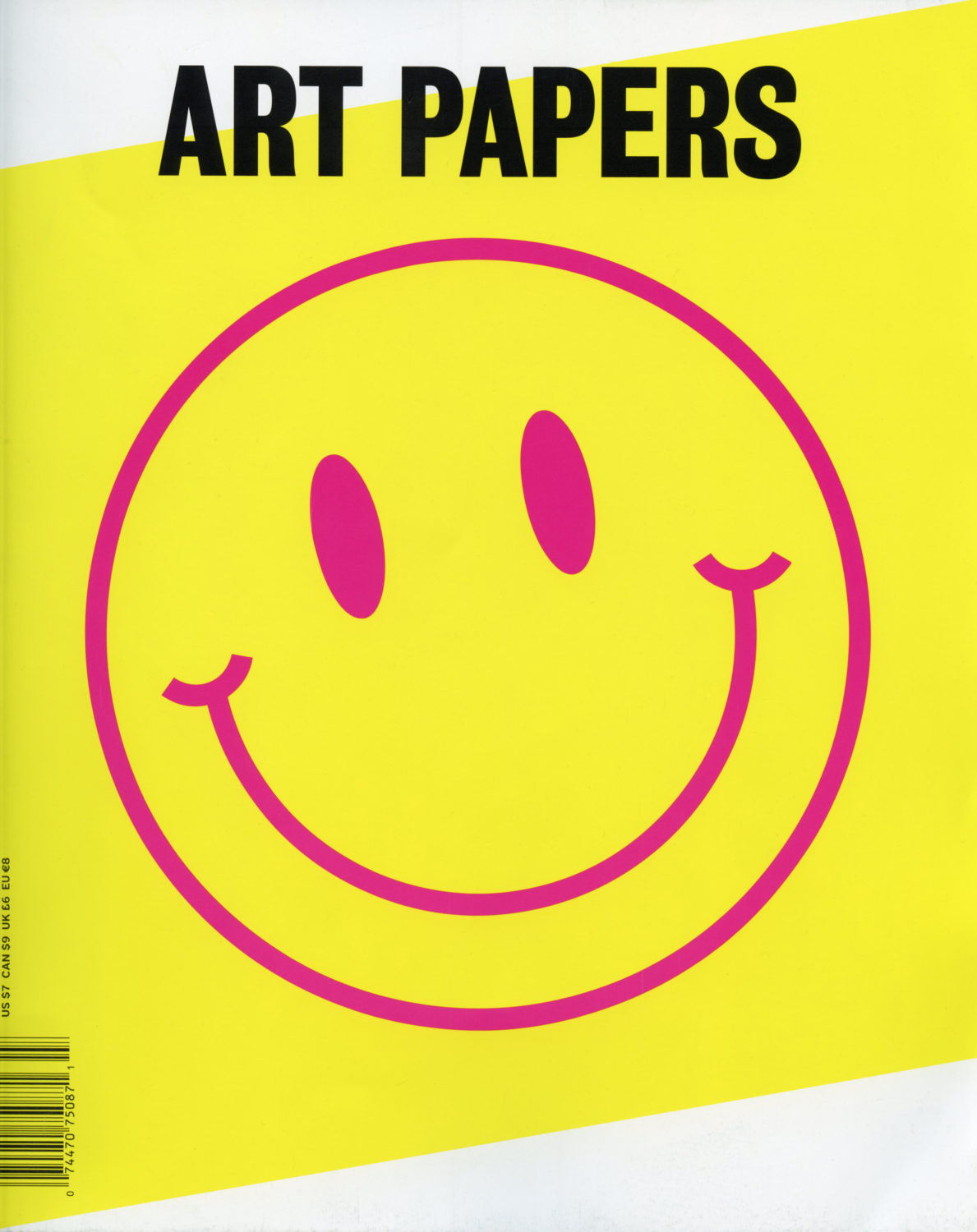
2016
Toward Now (Or Are We Headed for Somewhere Else?)
Guest editor Ryan Gravel’s “Terminus: Transportation Special Issue” with which the year began introduced spaces in between and the links between them, from M+ and its rail hub in Hong Kong to Atlanta’s Beltline and its public art, alongside Atlanta’s MARTA rail and its older public art program, plus the world’s busiest airport and its vacant fringes on Atlanta’s southside, the Megabus tying together economically abandoned margins, and the provocatively titled “Black Folks on Bikes.” The next issue began with R. B. Kitaj’s First Diasporist Manifesto and continued to the media that connect diasporas, from cassettes to renewed uses of radio. The succeeding issue dealt with “Water” in ways that ranged from the ecofeminism of SeedsInService’s urban gardening to Atlanta artist Michi Meko on how his theme of Black Buoyancy became literal when he found himself unexpectedly submerged. Greece returned as a multilayered topic with a discussion of the ways Athens artists have sought to escape from the city’s “othering” as a site of crisis by re-examining its place at the edge of an often contested sea. Then the July/August issue responded to a difficult 2016 with a glossary essay on “anxiety,” artistic responses to literal and metaphoric sicknesses, a study of the proposed demolition of Marcel Breuer’s final piece of architecture, the Atlanta-Fulton Central Library (now tentatively slated for preservation), and an Italian artist’s request for an open-source search for a cure for his cancer. This last project led to a summer school with “a transdisciplinary curriculum devised on the theme of inhabiting the city and the planet in the age of interconnectivity.” This nod to grounds for global optimism rhymed with the long-enduring smiley-face icon on the cover, quoted from a flag in London’s UTOPIA 2016, a multidisciplinary homage to the quincentenary of Thomas More’s Utopia. As a 40+ year old symbol of persistent cheerfulness in the face of continuous challenge, the icon also made an appropriate symbol for this anniversary year of Art Papers.